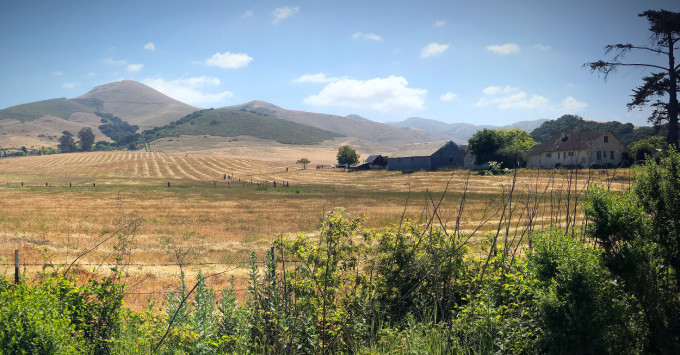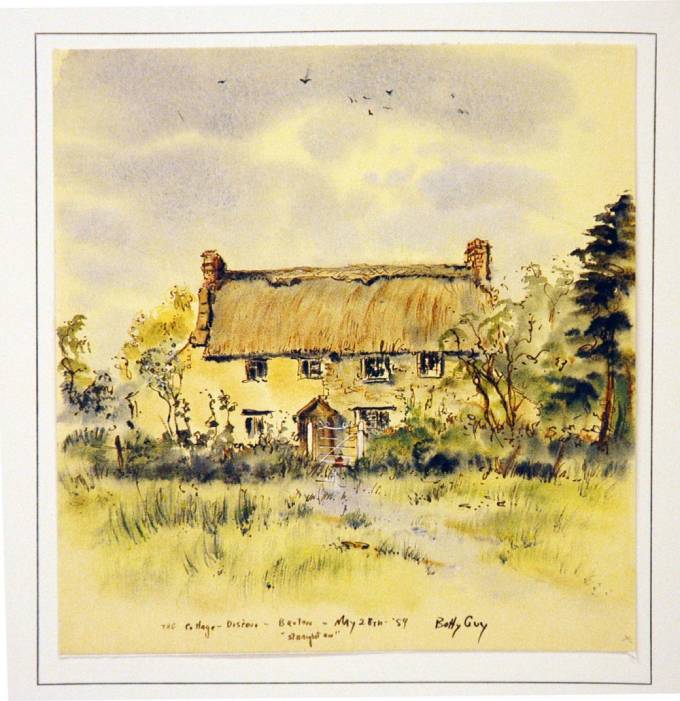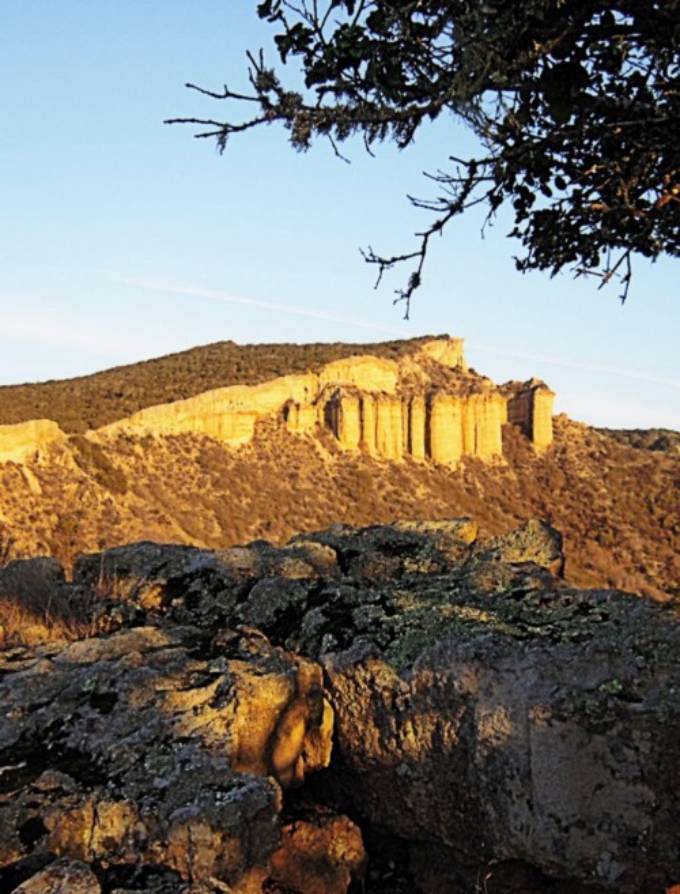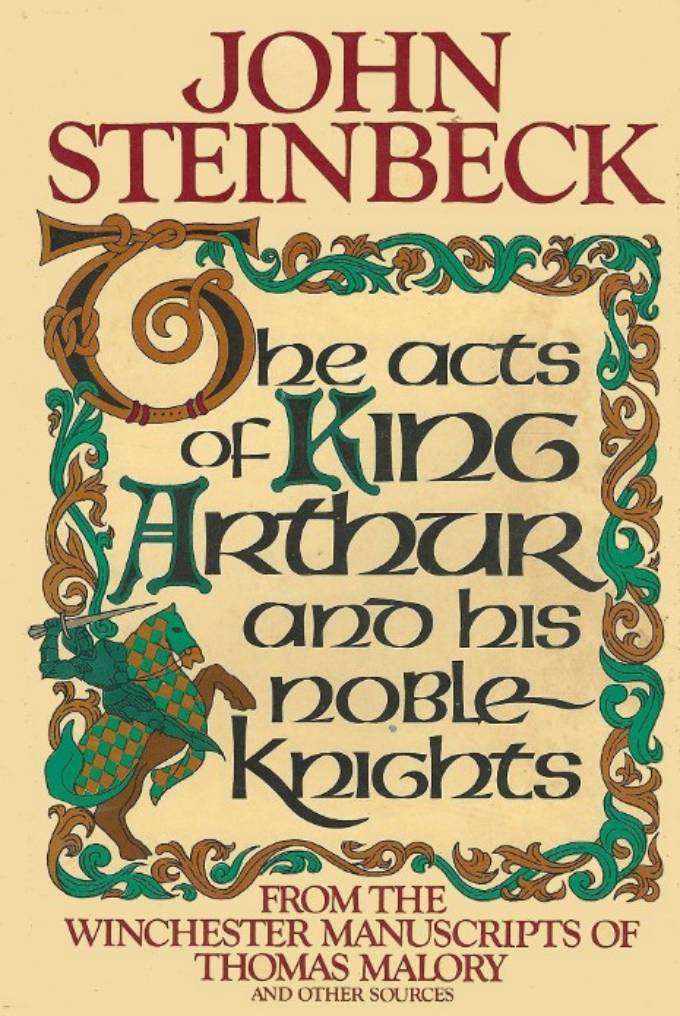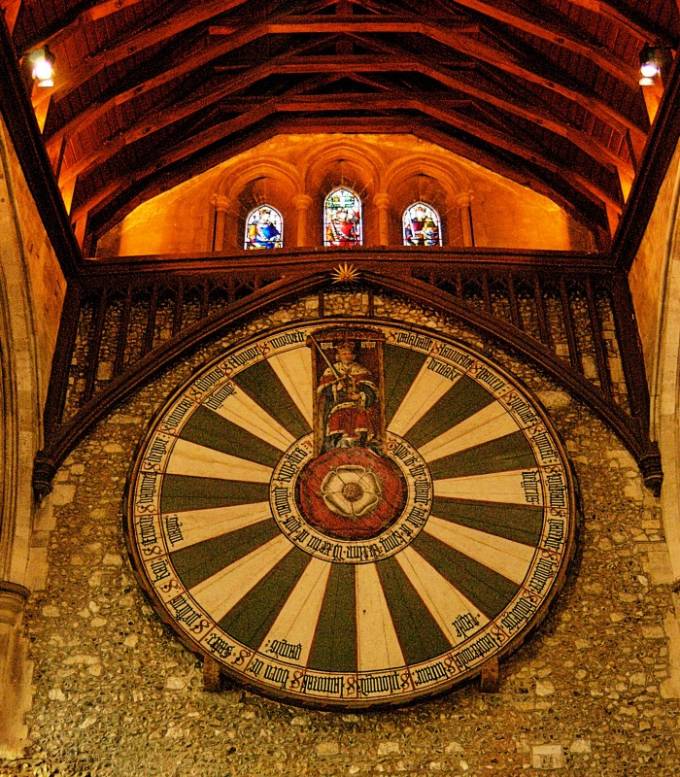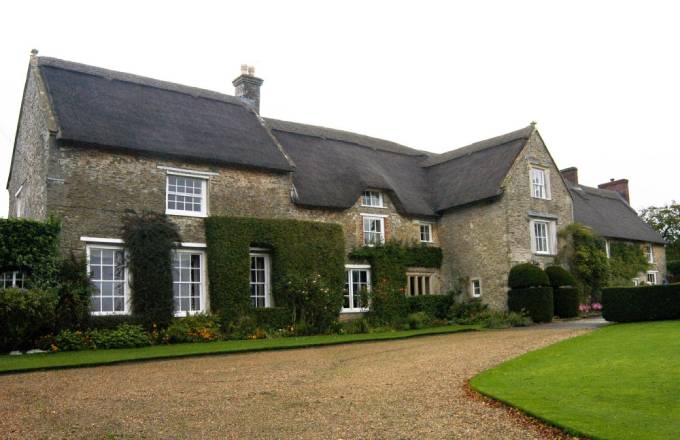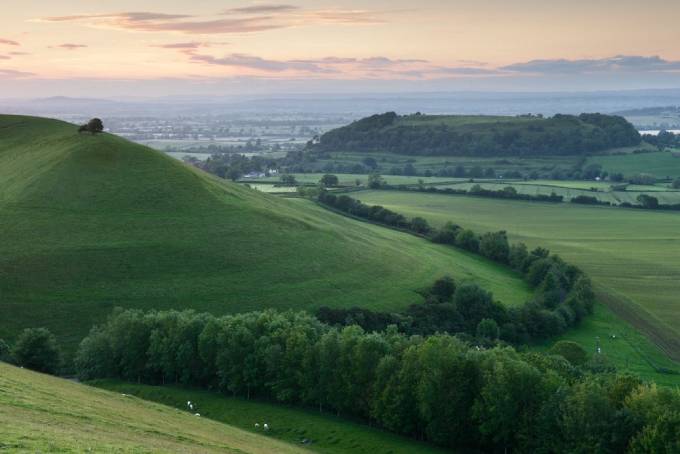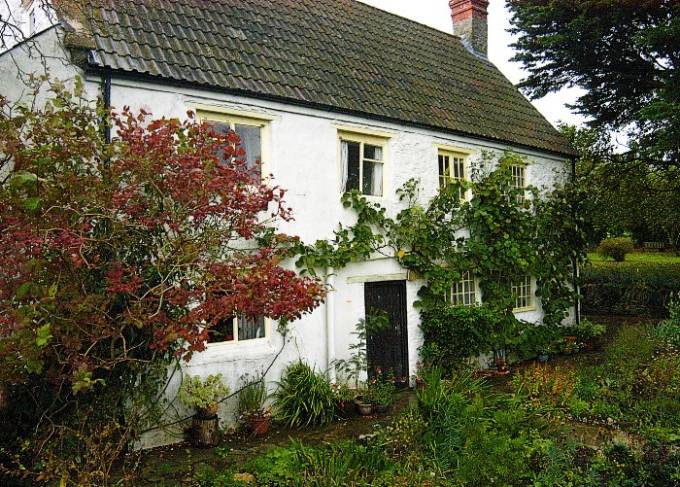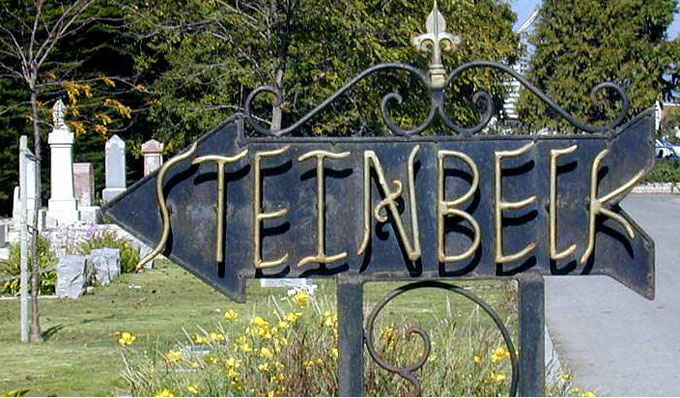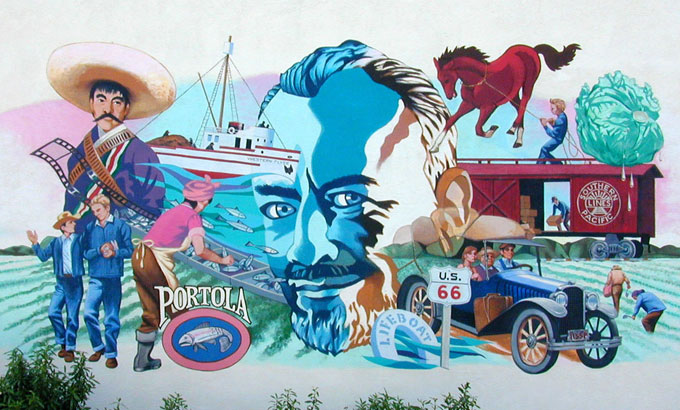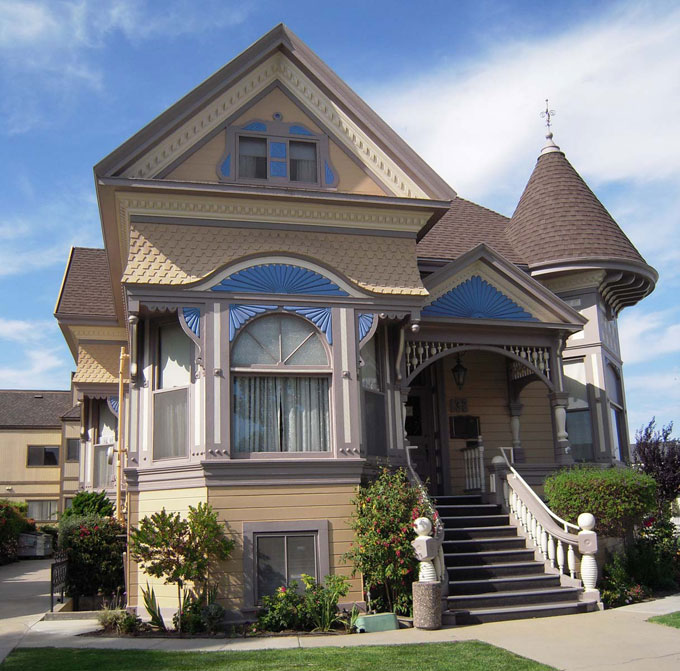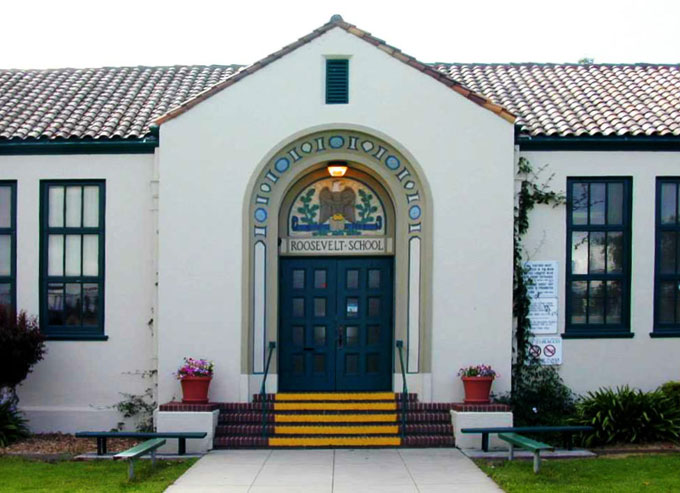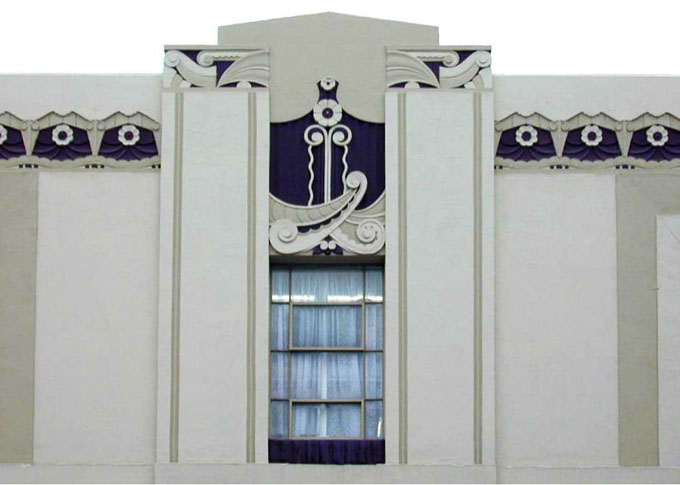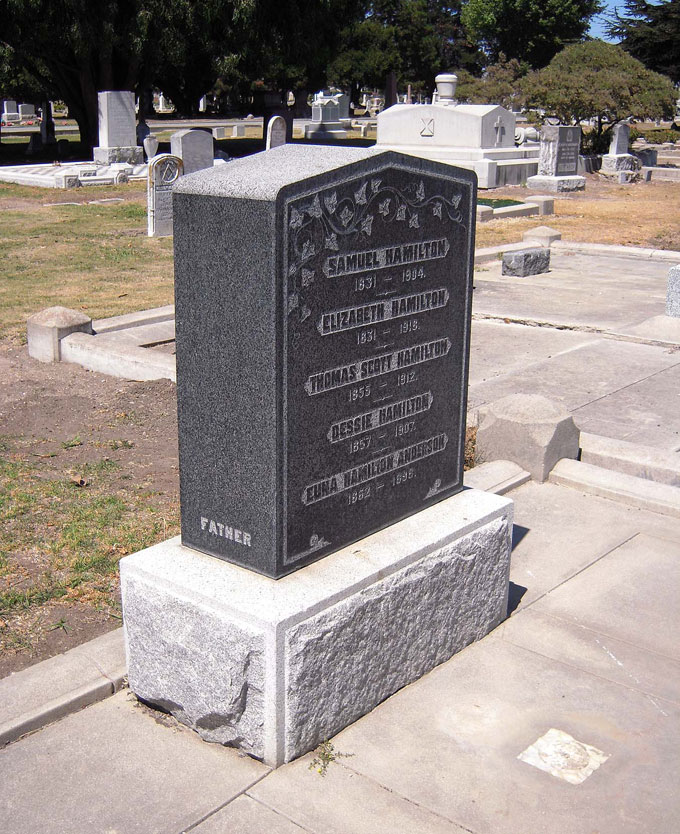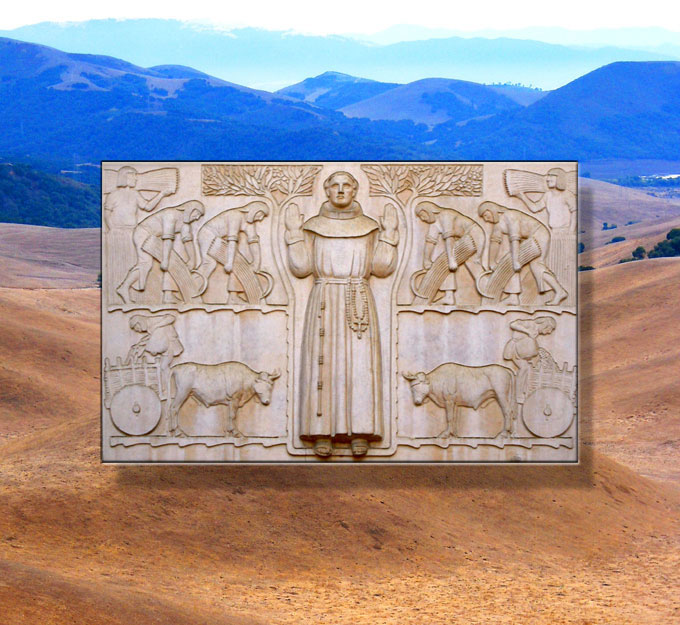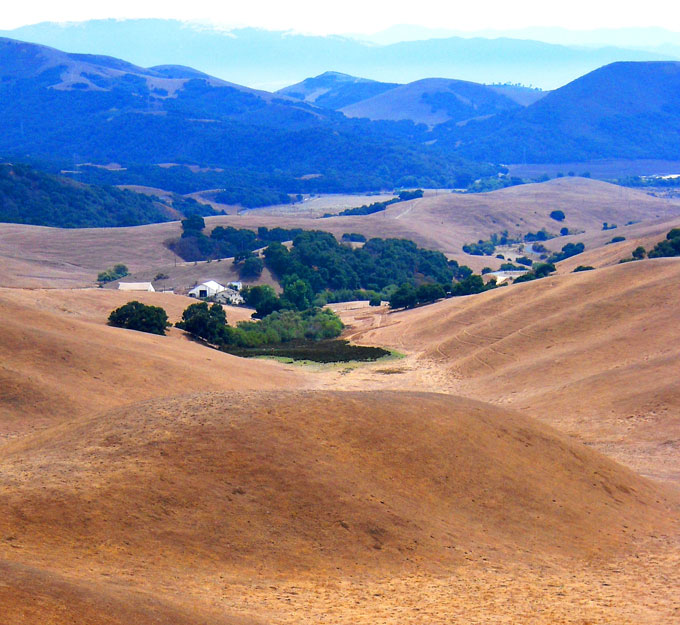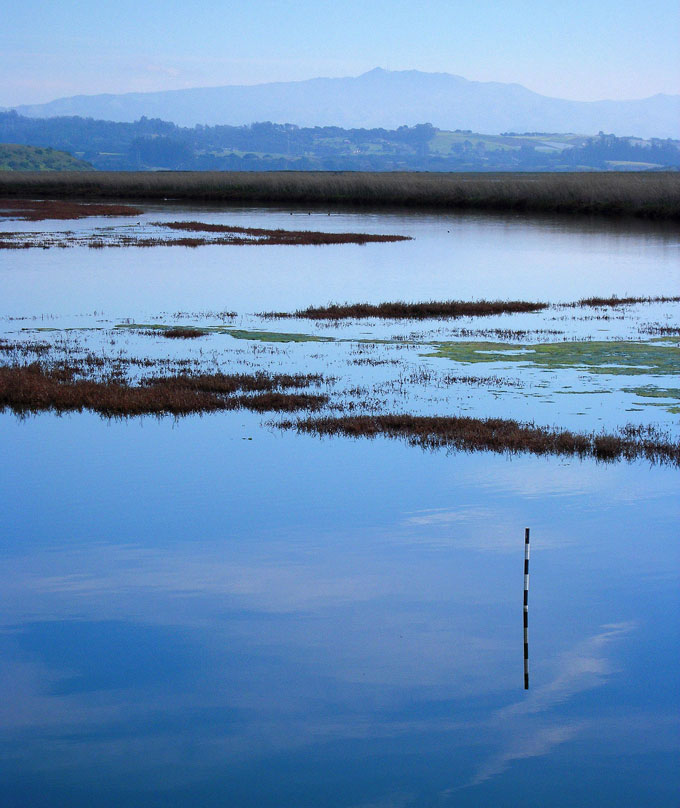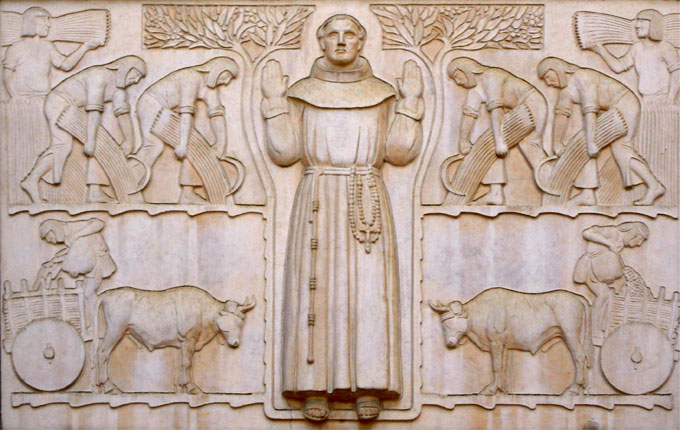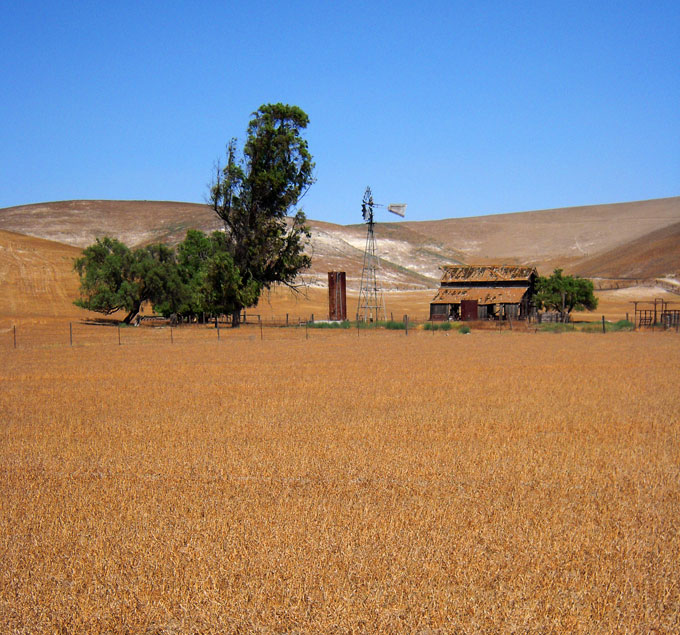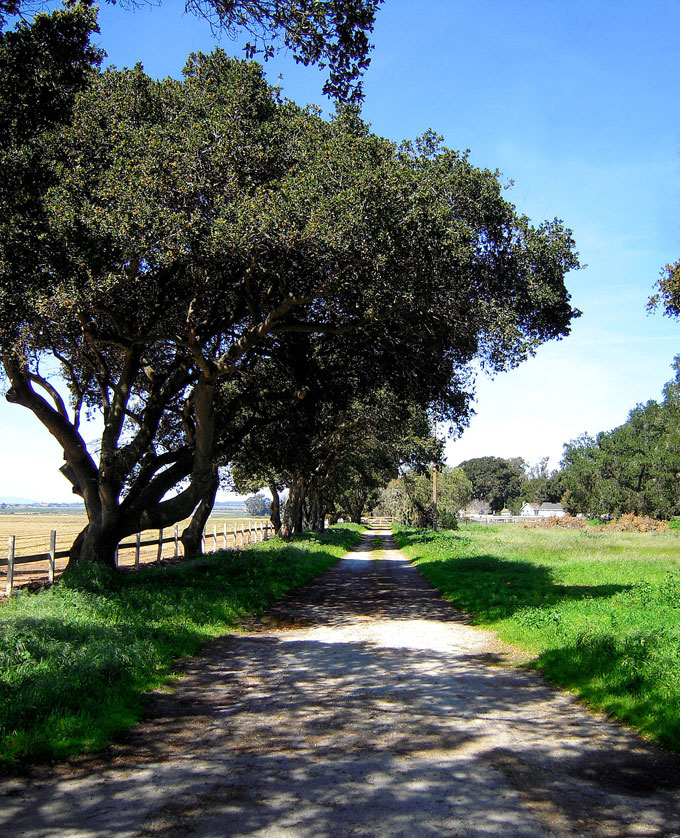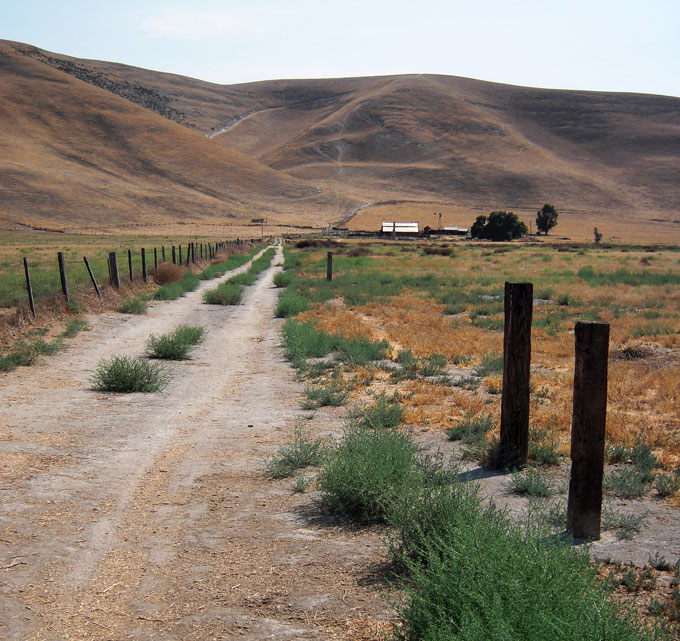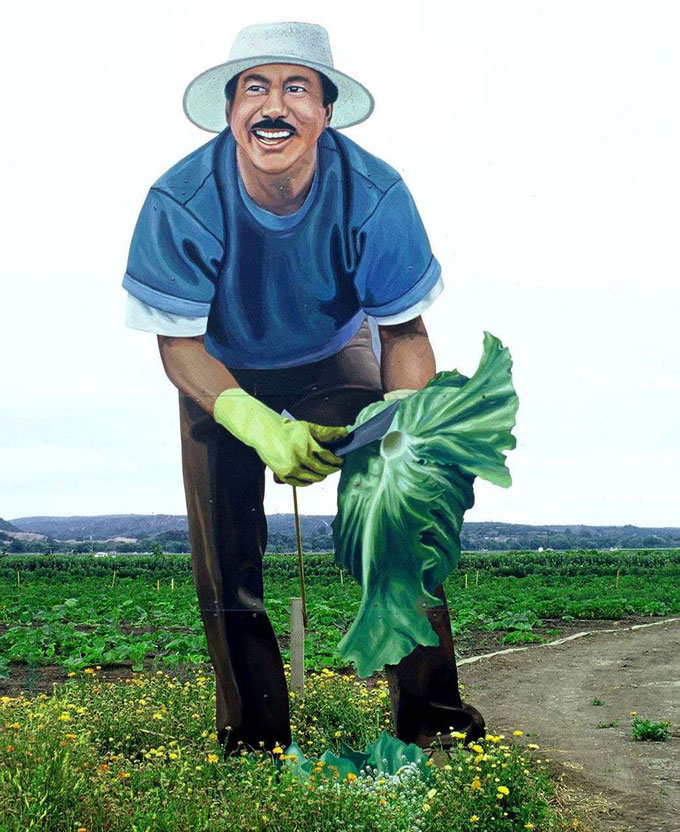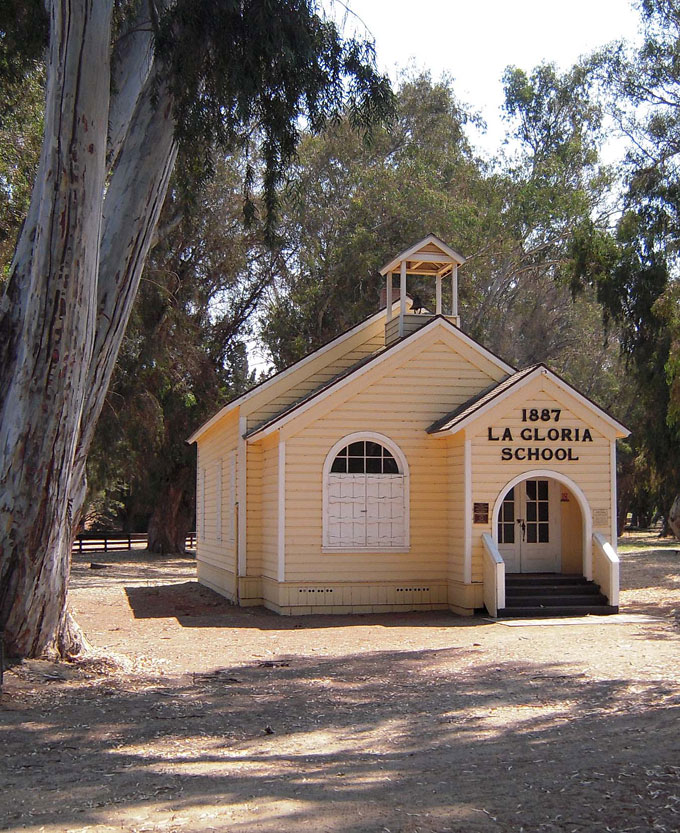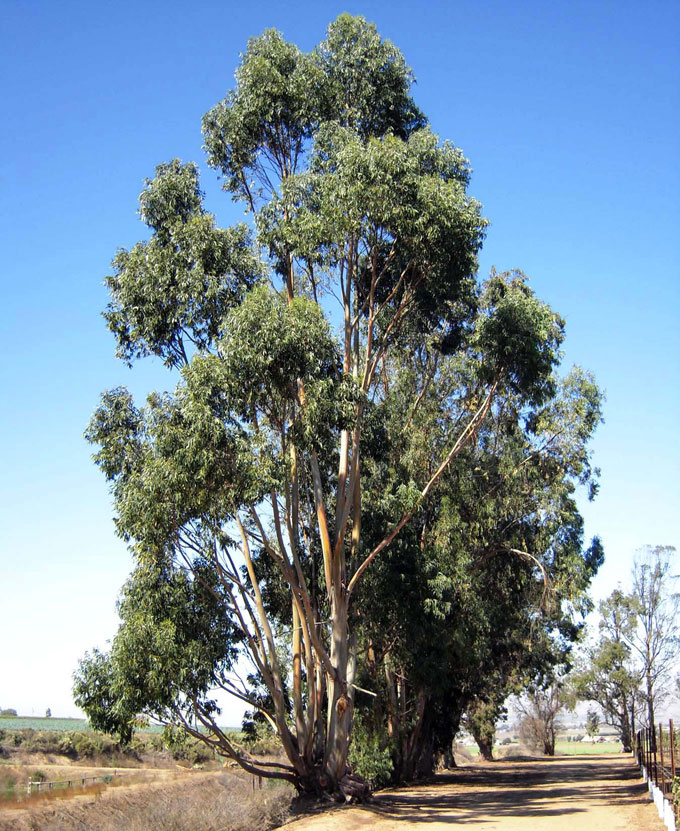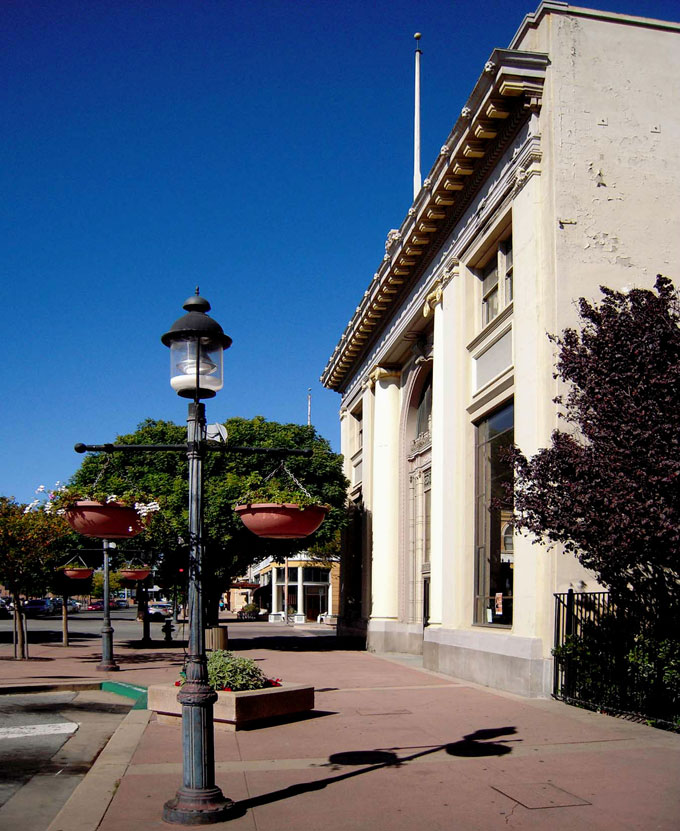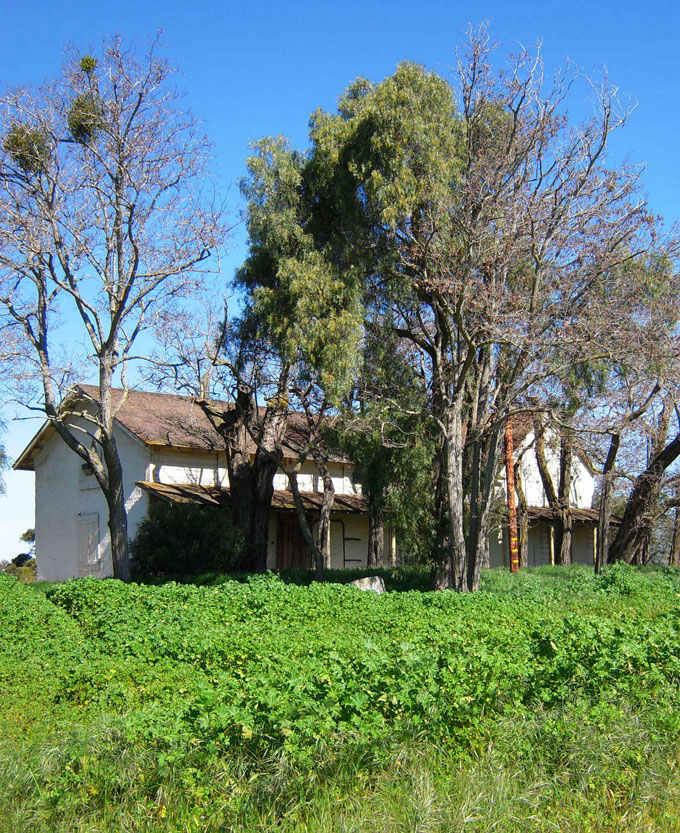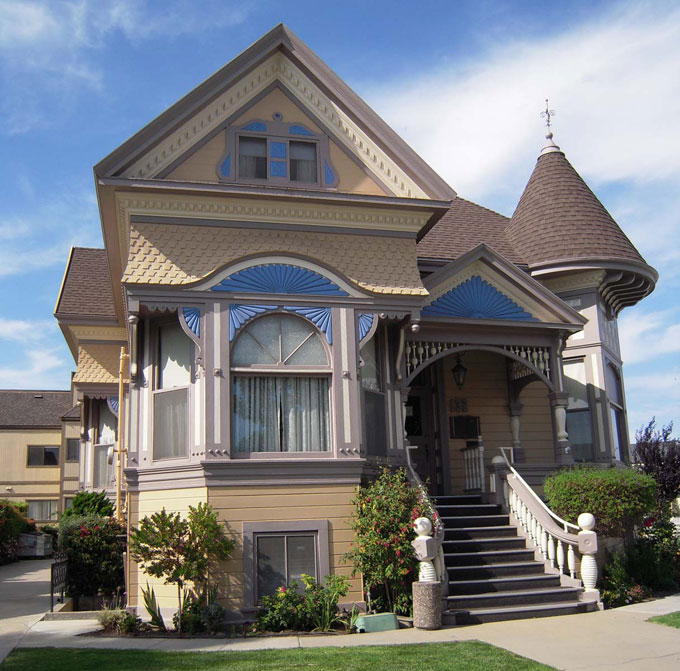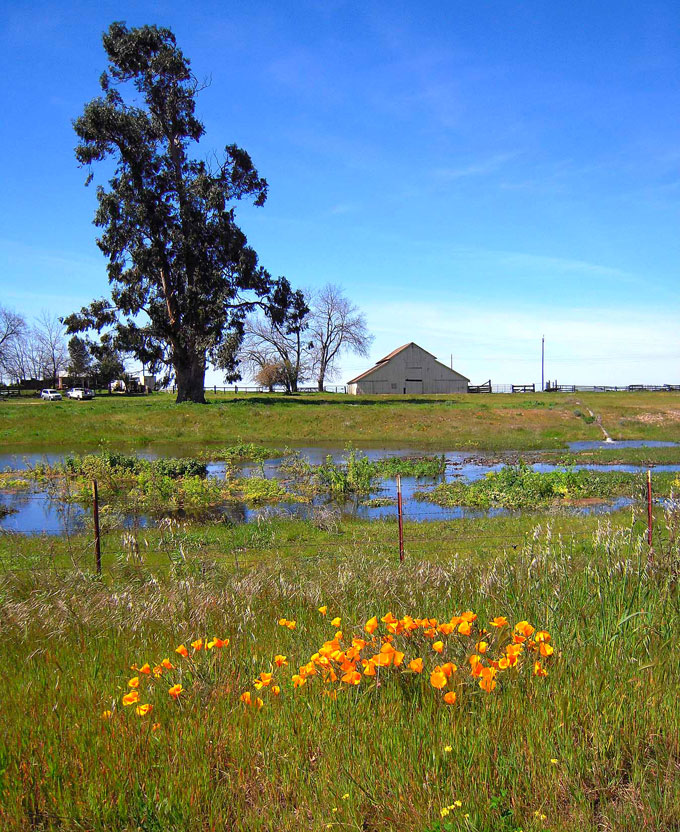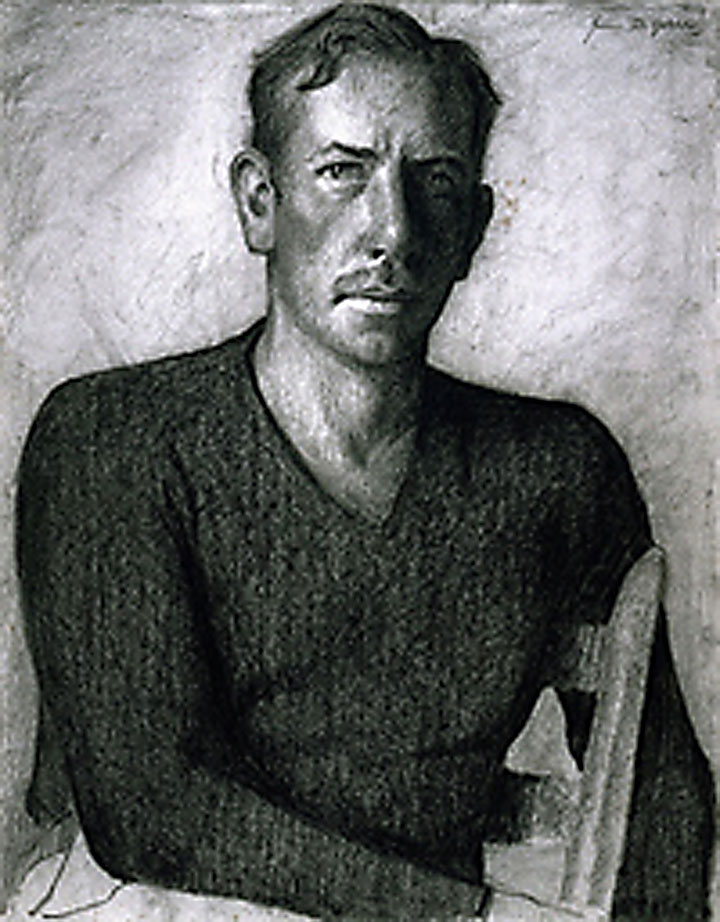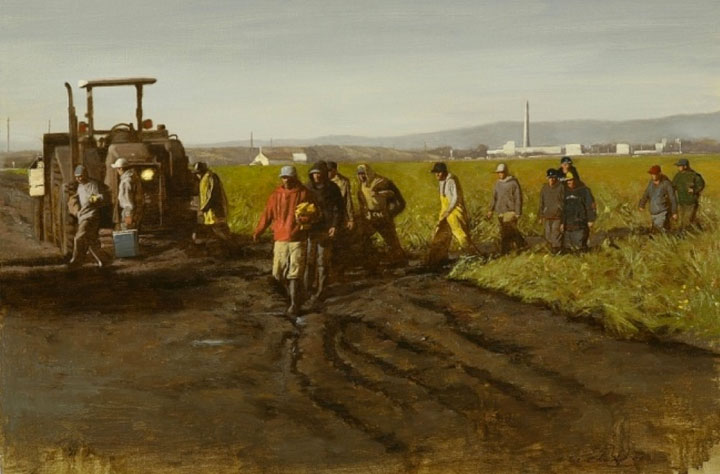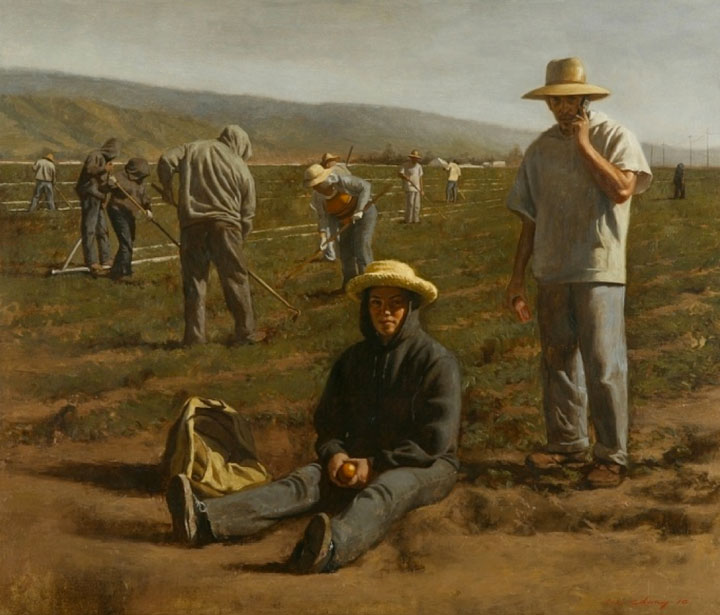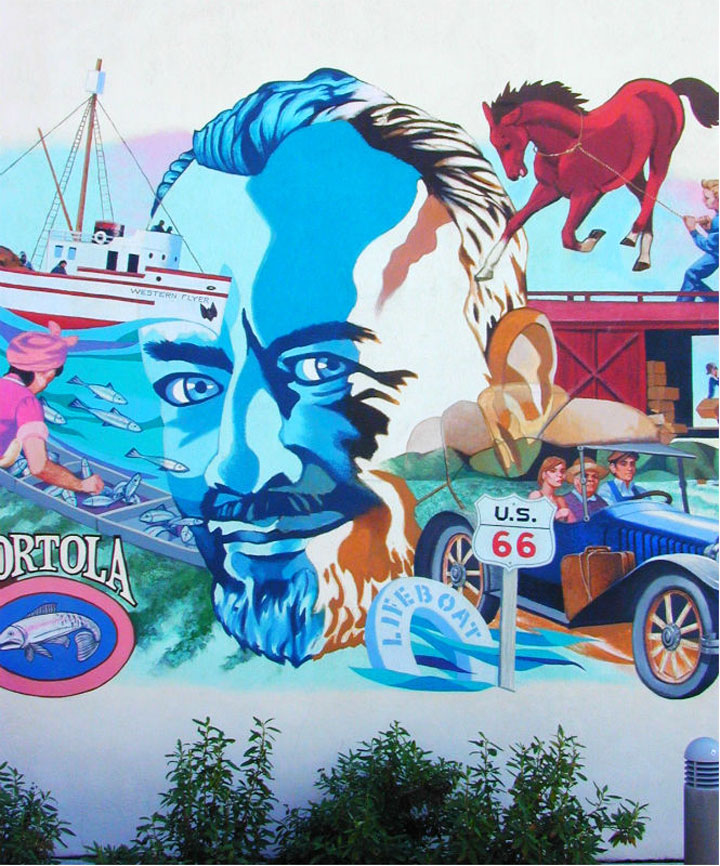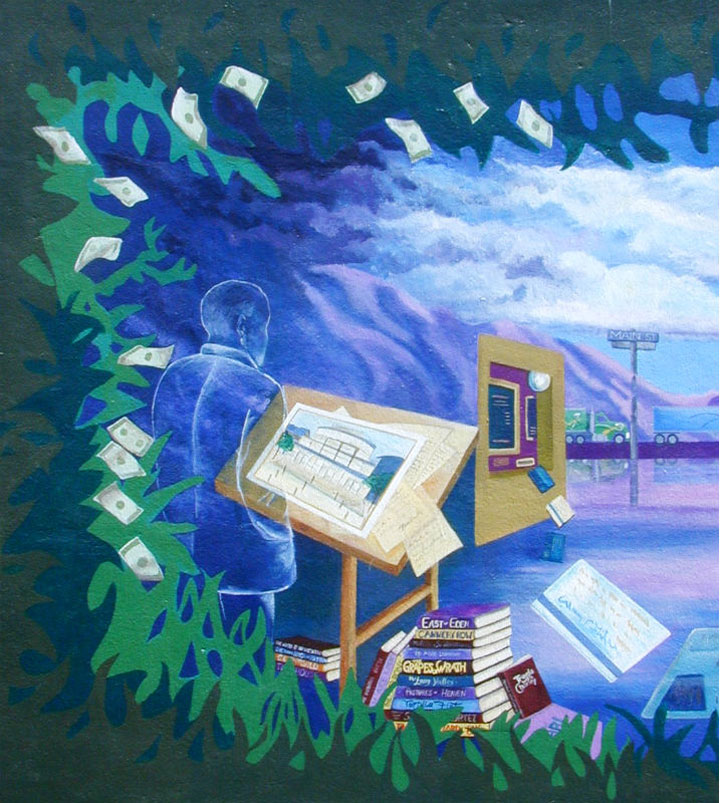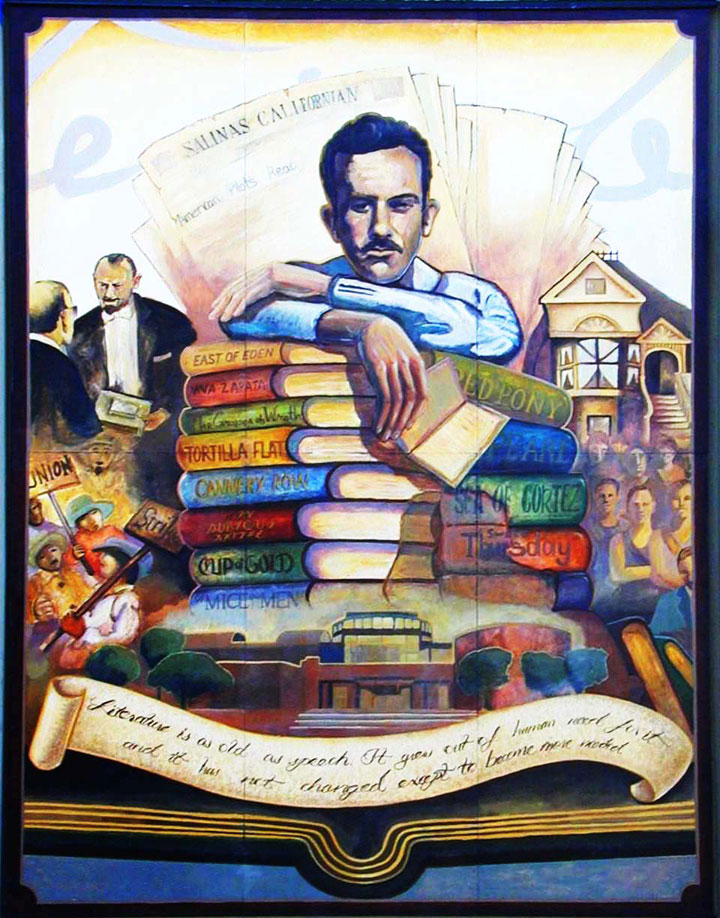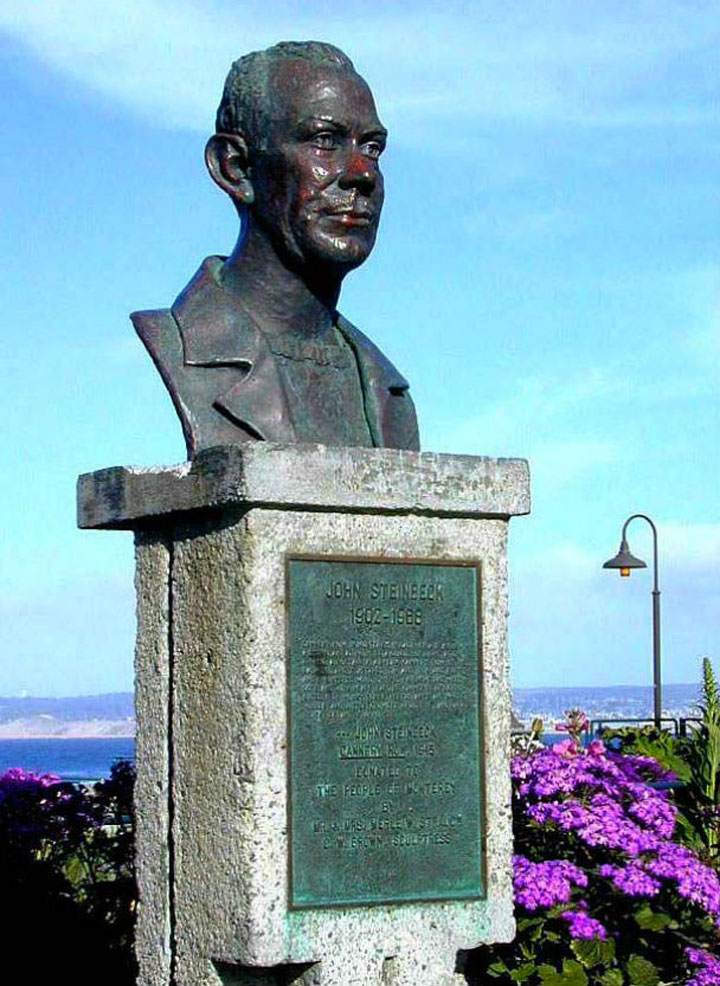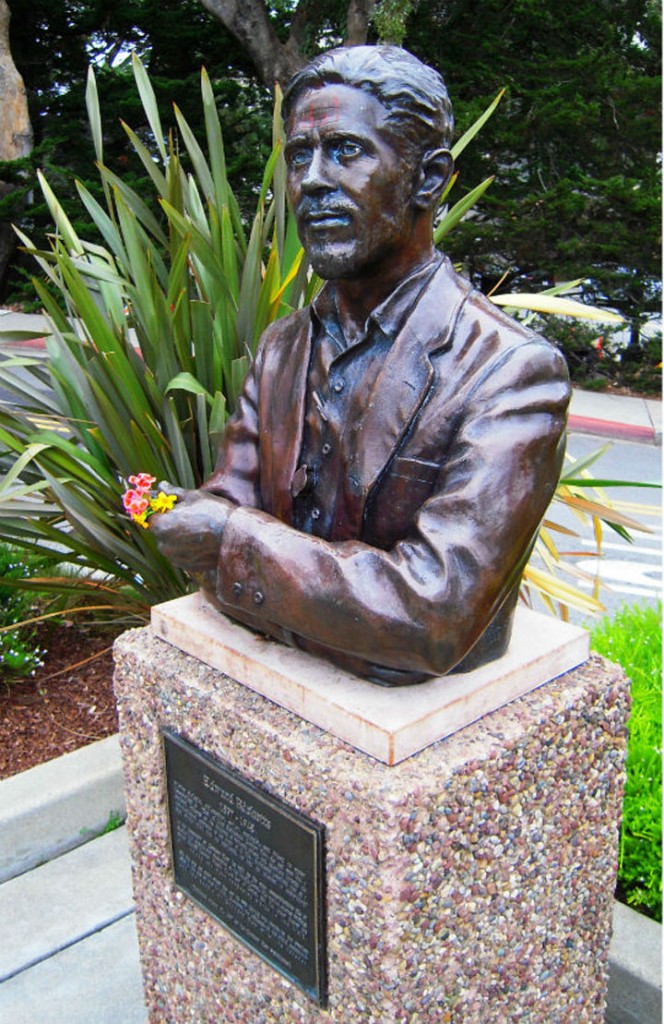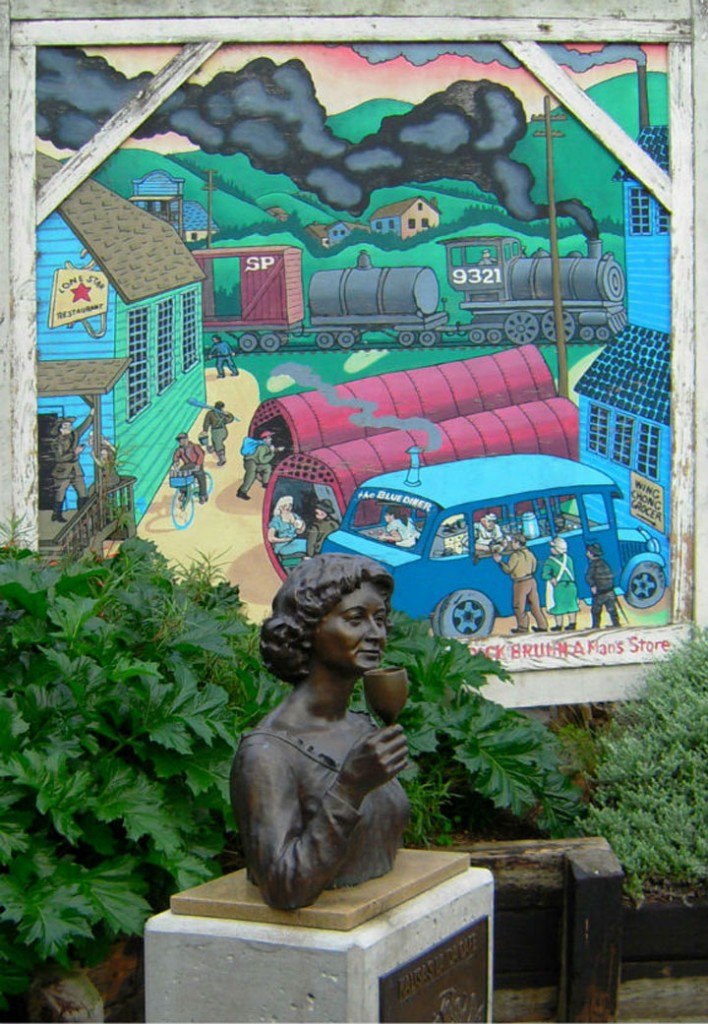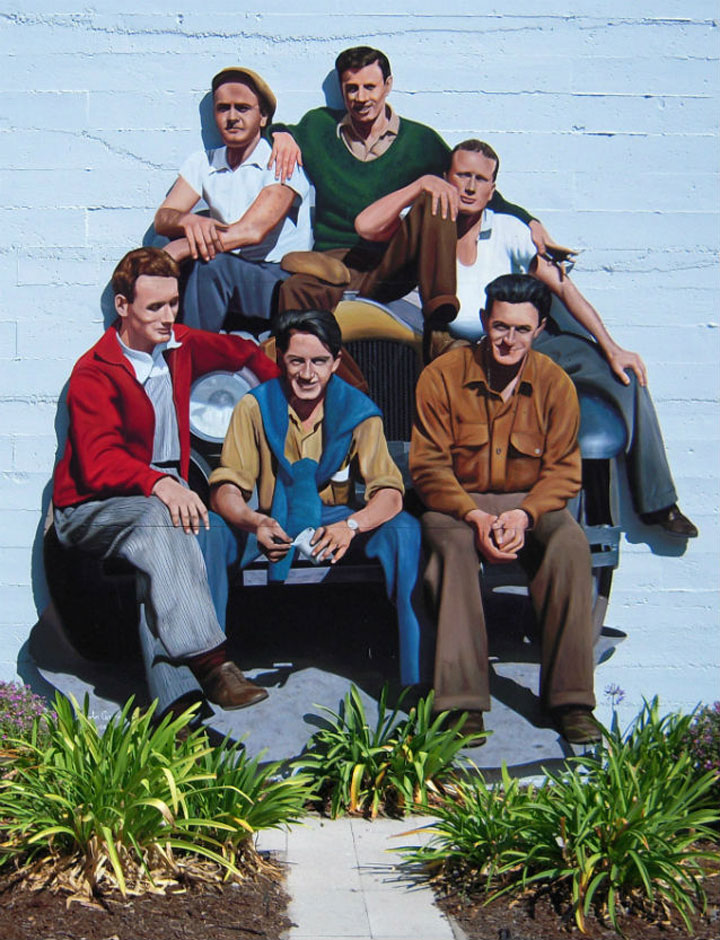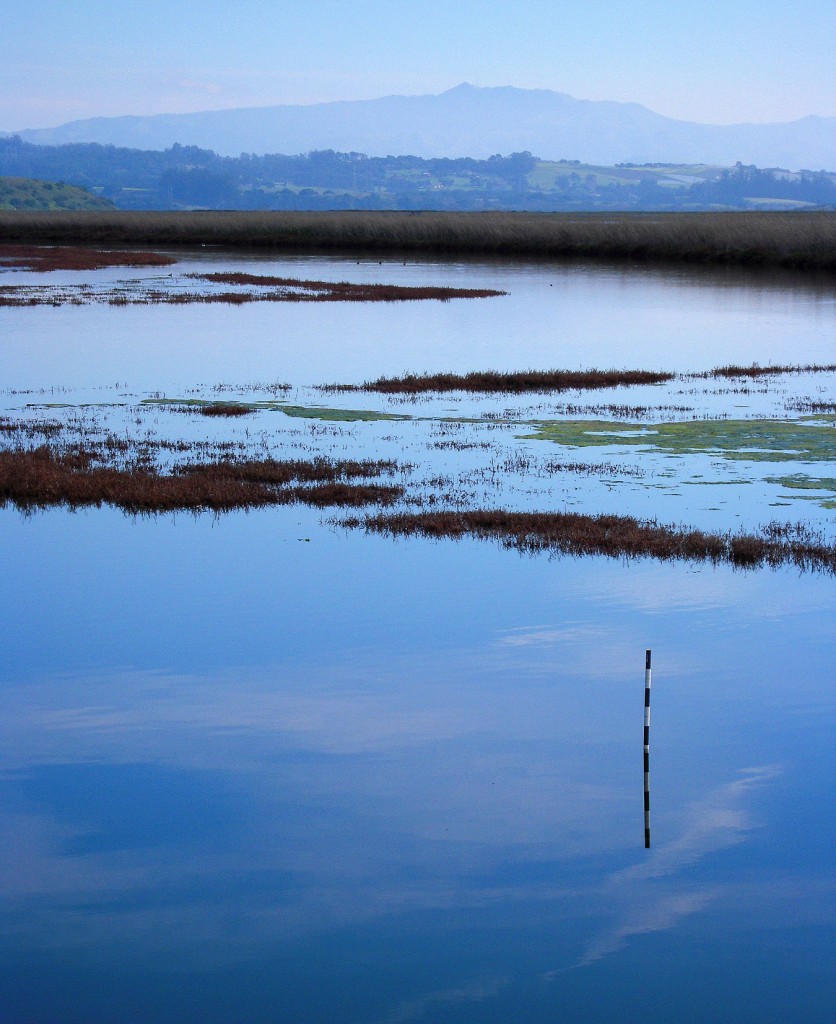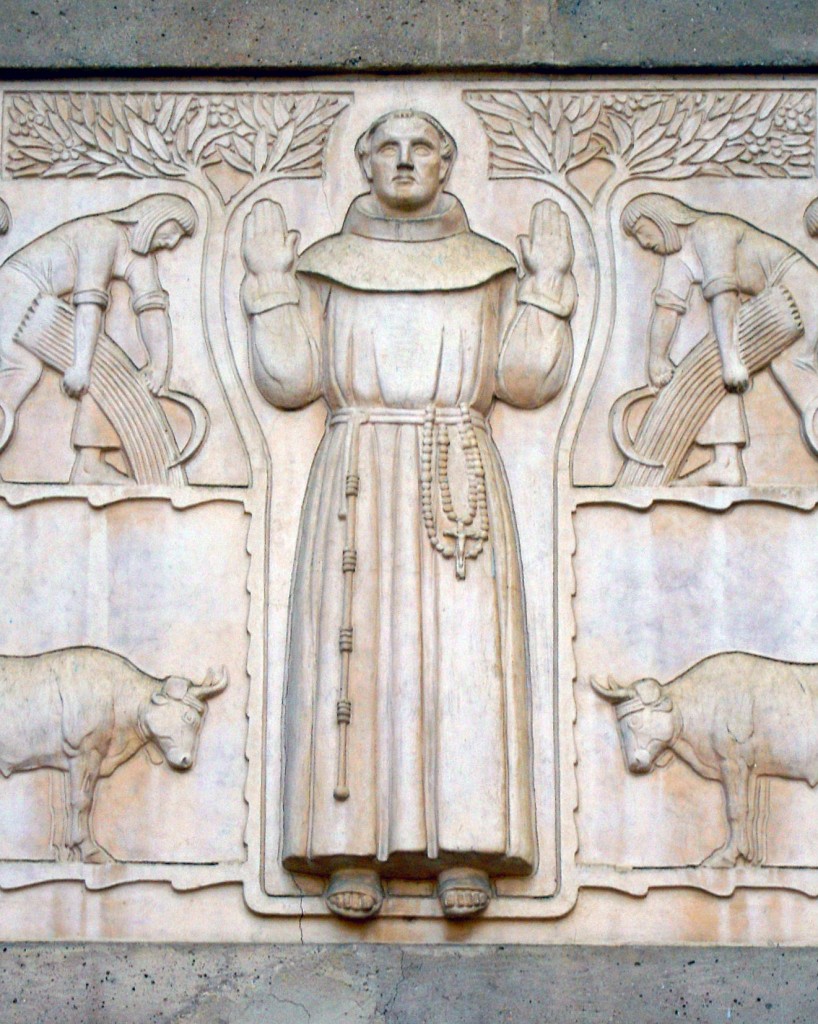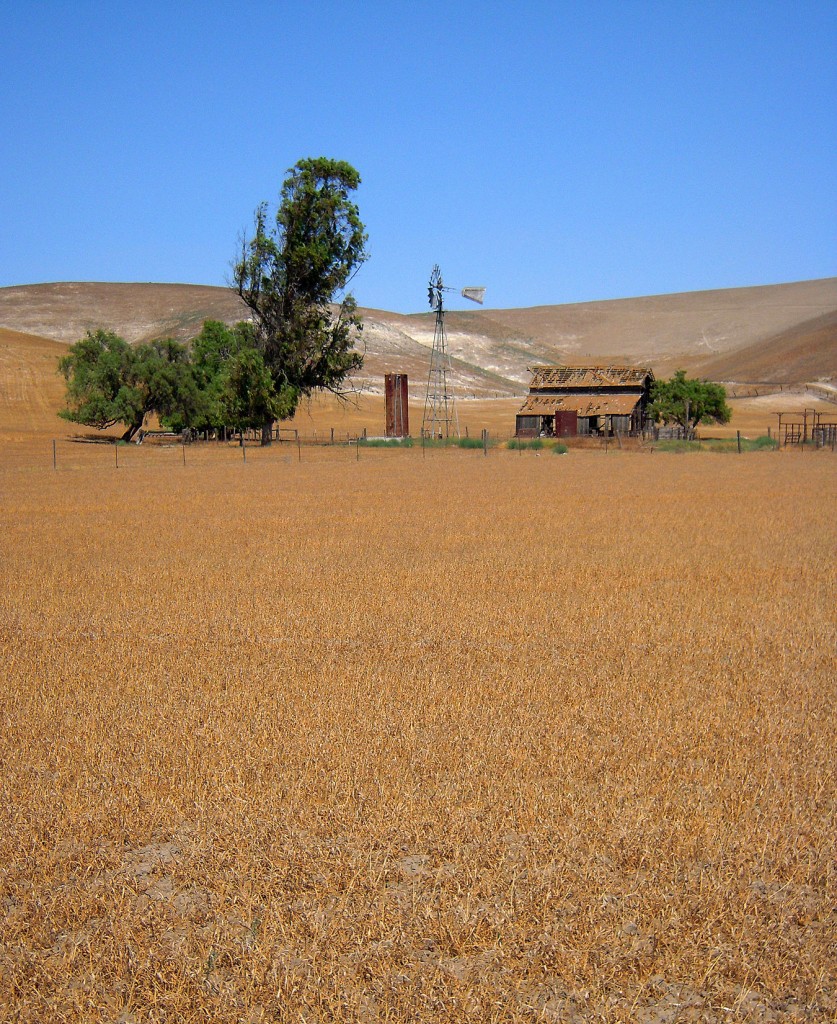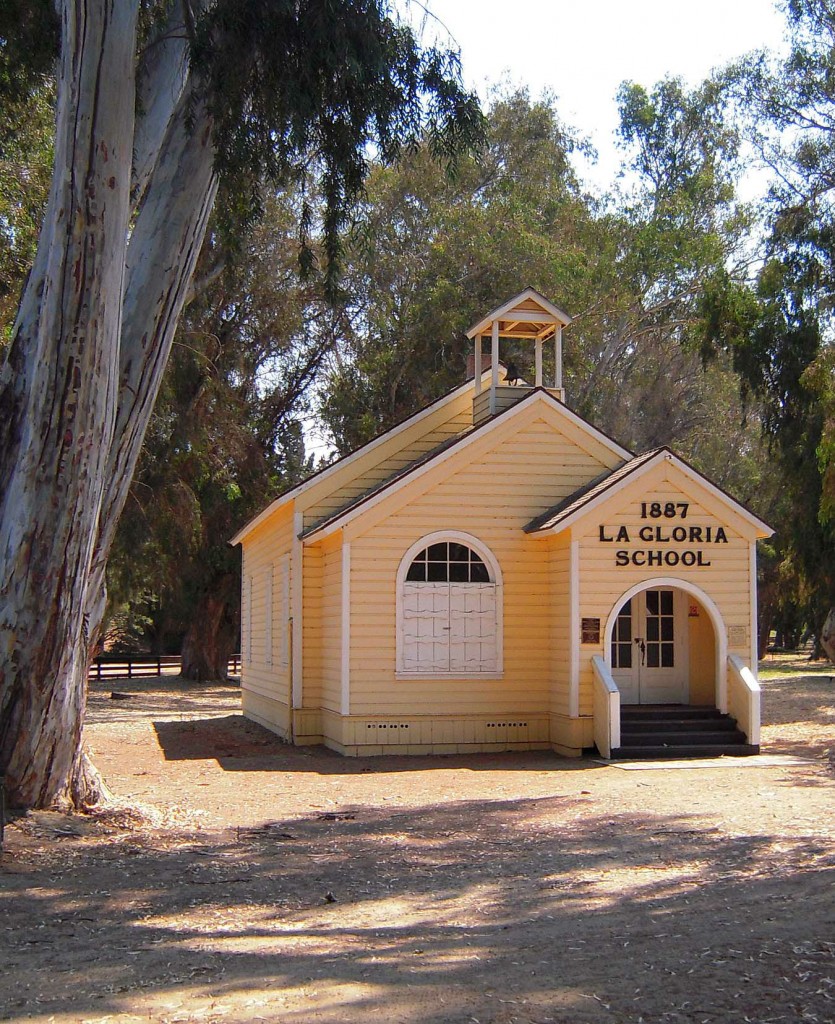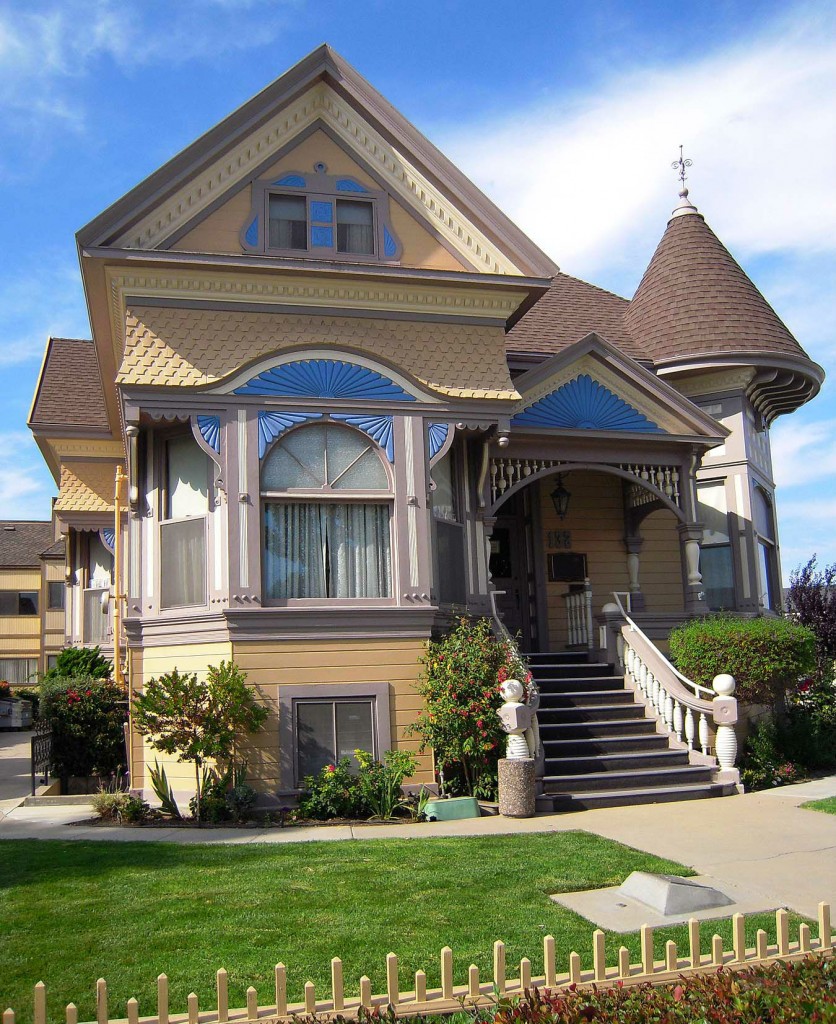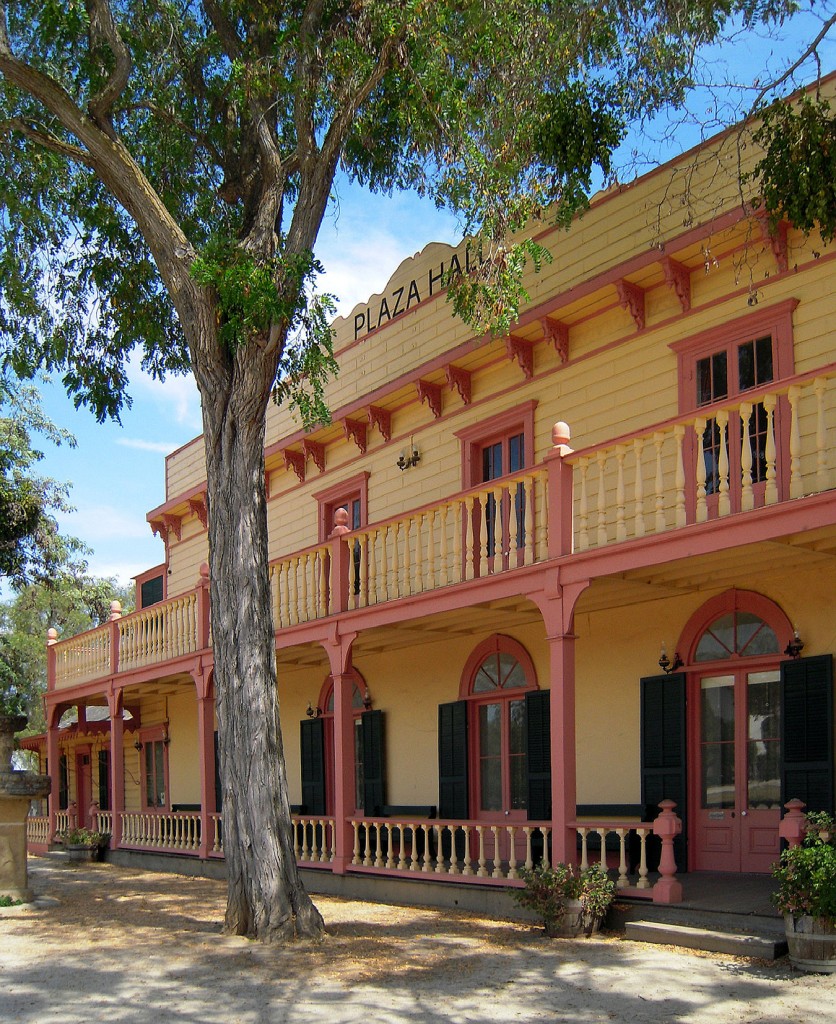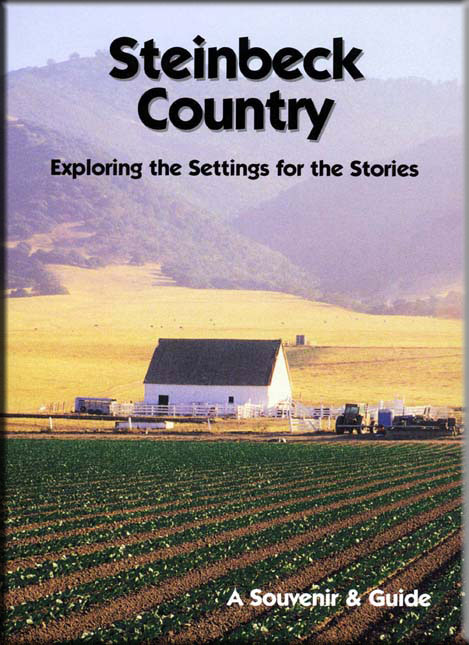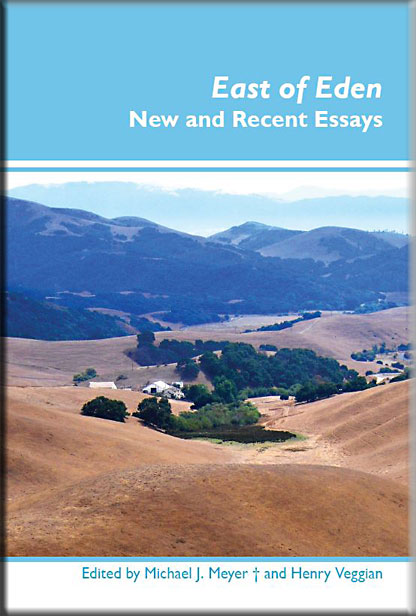Twenty years ago I took photographs of Monterey County’s Steinbeck Country to present at the Steinbeck Centennial Conference held at Hofstra University in New York. The images, together with expanded text linking them to quotations from the writer’s work, were published as “The Settings for the Stories” in Steinbeck Review, Volume 6. Number 1, Spring 2009. In May 2021, I retraced the Salinas Valley route to see how the landscape looks two decades later. See “John Steinbeck’s Valley of the World Revisited: A Photo Essay” for images like this one, taken of a ranch in “the wilder hills” from Salinas Valley’s historic Old Stage Road.
John Steinbeck’s “Time at Discove” in England’s Camelot Country
“Bruton is the only spot in the world I have refused to see again since John died.”
– Elaine Steinbeck
Elaine Steinbeck’s comment in a 1992 letter to the artist Betty Guy refers to the time that she and her husband John Steinbeck spent at Discove Cottage in Bruton, Somerset, England, while he worked on his “reduction of Thomas Malory’s Morte d’Arthur to simple readable prose without adding or taking away anything.” The story behind the story of Steinbeck’s Arthurian quest started 80 years earlier, in California.
The Road from Castle Rock
Steinbeck became fascinated with the legends of King Arthur and the Round Table after his Aunt Molly Martin presented him with a child’s version of the epic tales of chivalry and knighthood on his ninth birthday. He created a secret language based on Malory’s text and, with his sister Mary, played among the exotic eroded turrets of Castle Rock in Corral de Tierra, near Salinas, as their imaginary Camelot. Arthurian themes appeared in Cup of Gold, Tortilla Flat, Of Mice and Men, and many other writings. He began working on Arthur in earnest after completing The Short Reign of King Pippin IV in 1957, work that went through numerous false starts and iterations and consumed Steinbeck for the rest of his life. As late as 1965, in a letter to the actor Douglas Fairbanks Jr., Steinbeck wrote: “Perhaps you will remember that for at least thirty-five years, and maybe longer, I have been submerged in research for a shot at the timeless Morte d’Arthur. Now Intimations of Mortality warn me that if I am ever going to do it, I had better start right away, like next week.”
Ultimately Steinbeck failed in his quest to transpose the music of Malory’s language for modern ears. Two unfinished draft manuscripts survive, one created in Somerset, the second written some years after his return. Initially concerned that it would detract from his reputation, Elaine relented to posthumous publication when she realized that her husband had incorporated references to his love for her. Edited by Chase Horton (owner of the Washington Square Bookstore in New York and a friend of his agent Elizabeth Otis), The Acts of King Arthur and His Noble Knight appeared in 1976. The volume includes an extensive appendix drawn from the author’s letters and journals.
In his correspondence, Steinbeck describes the heights of elation and the depths of despair he experienced while pursuing his search for artistic perfection.
In this correspondence, the writer describes the heights of elation and the depths of despair he experienced while pursuing his search for artistic perfection. One unwavering theme is the sense of joy and contentment in the simple lifestyle he enjoyed during the months spent researching and writing in Discove Cottage, near Bruton in Somerset, England, in 1959. The biographies of Steinbeck by Jackson J. Benson (The True Adventures of John Steinbeck, Writer) and Jay Parini (John Steinbeck: A Biography) recount Elaine’s recollection of a conversation with her husband during his final hours of life. He asked her, “What’s the best time we ever had together?” “The time at Discove,” they agreed. Parini quotes Elaine: “John had discovered something about himself in Discove Cottage.”’ Elaine never returned to Discove, but she remained friendly with the owner, Mrs. Kay Leslie, and she visited the Leslies several times after they sold the cottage to Mr. and Mrs. David Whigham in 1977. Perhaps recalling her husband’s disappointing return to Monterey as recounted in Travels with Charley, Elaine did not wish to disturb the memories of their idyllic sojourn in that humble rural cottage.
Exploring England’s Camelot Country
During 1957 and 1958, the Steinbecks traveled Europe in search of original material. John researched in the Vatican libraries in Rome as he believed Sir Thomas Malory had traveled to Italy as a mercenary. In England they met with Professor Eugene Vinaver, a scholar and authority on the 15th century, and toured many Arthurian locations across the country, including Glastonbury Tor in Somerset, the heart of King Arthur Country, and the medieval replica of the Round Table at Winchester Castle. Stage and screenwriter Robert Bolt (A Man for All Seasons, Lawrence of Arabia, Doctor Zhivago), who taught English at the nearby Millfield school, introduced them to other ancient English traditions, including cricket and the village pub.
‘I am depending on Somerset to give me the something new which I need,’ wrote Steinbeck.
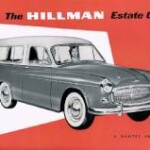 In July 1958, Steinbeck started work on the translation at his retreat in Sag Harbor, New York, but soon reached an impasse in his search for an appropriate “path or a symbol or an approach.” Believing that he could find this thread in England (“I am depending on Somerset to give me the something new which I need”), he and Elaine crossed the Atlantic again in February 1959. They landed at Plymouth, took delivery of a Hillman Minx estate car (station wagon), and drove to the ancient market town of Bruton. Here they rented Discove Cottage, located for them by Robert Bolt on the estate of Discove House. Steinbeck was so pleased with Bolt’s find that he presented him a gift of the complete thirteen-volume edition of the Oxford English Dictionary.
In July 1958, Steinbeck started work on the translation at his retreat in Sag Harbor, New York, but soon reached an impasse in his search for an appropriate “path or a symbol or an approach.” Believing that he could find this thread in England (“I am depending on Somerset to give me the something new which I need”), he and Elaine crossed the Atlantic again in February 1959. They landed at Plymouth, took delivery of a Hillman Minx estate car (station wagon), and drove to the ancient market town of Bruton. Here they rented Discove Cottage, located for them by Robert Bolt on the estate of Discove House. Steinbeck was so pleased with Bolt’s find that he presented him a gift of the complete thirteen-volume edition of the Oxford English Dictionary.
Discove House is a Grade II Listed Building. The two-storey stone house features a projecting porch and a steep thatched roof between coped gables. Although it does exhibit earlier features, much of the structure dates from the 17th century. At 140 feet in length, the house is said to be the longest thatched residence in England. Steinbeck called it an “old manor house,” but Discove was more likely the dower house for the nearby Redlynch Estate of the Earls of Ilchester. A dower house is a residence reserved for the widow when an entailed estate passes on to the older son.
Discove Cottage is a former farm laborer’s dwelling hidden from the road in the fields behind the main house.
Discove Cottage is a former farm laborer’s dwelling hidden from the road in the fields behind the main house. It has two bedrooms upstairs and a kitchen-dining room and a living room downstairs. According to Steinbeck, “It has stone walls three feet thick and a deep thatched roof and is very comfortable . . . . It is probable that it was the hut of a religious hermit. It’s something to live in a house that has sheltered 60 generations.”
The name Discove is believed to derive from a combination of the proper names Dycga or Diga and the Anglo-Saxon word for bedchamber or hut.
The name Discove is believed to derive from a combination of the proper names Dycga or Diga, used by monks 600-800 AD, and the Anglo-Saxon word cove, for bedchamber or hut. In the 1086 AD Doomsday Book of William the Conqueror, it is recorded as Dinescove. The surrounding area has been occupied since ancient times. A possible barrow, or Neolithic burial chamber, has been identified at Redlynch, and a tessellated pavement from the Roman era, 1,000 years before the Conqueror, was uncovered at Discove in 1711.
‘We are right smack in the middle of Arthurian Country.’ wrote Steinbeck. ‘And I feel that I belong here. I have a sense of relaxation I haven’t known for years. Hope I can keep it for a while.’
The Steinbecks settled into rural life quickly. “Elaine is seeding Somerset with a Texas accent,” wrote Steinbeck. “She’s got Mr. Windmill of Bruton saying you-all. At the moment, she is out in the gallant little Hillman calling on the vicar.” As for the task at hand, “If ever there was a place to write the Morte, this is it. Ten miles away is the Roman fort, which is the traditional Camelot. We are right smack in the middle of Arthurian Country. And I feel that I belong here. I have a sense of relaxation I haven’t known for years. Hope I can keep it for a while.”
“Yesterday I cut dandelions in the meadow and we cooked them for dinner last night—delicious,” Steinbeck reported. “And there’s cress in the springs on the hill. But mainly there’s peace—and a sense of enough time.” The praise approached mysticism. “I can’t describe the joy. In the mornings I get up early to have time to listen to the birds. It’s a busy time for them. Sometimes for over an hour I do nothing but look and listen and out of this comes a luxury of rest and peace and something I can only describe as in-ness. And then when the birds have finished and the countryside goes about its business, I come up to my little room to work. And the interval between sitting and writing grows shorter every day.” Elaine agreed: “John’s enthusiasm and excitement are authentic and wonderful to see. I have never known him to have such a perfect balance of excitement in work and contentment in living in the ten years I have known him.”
The grail of modern translation may have eluded Steinbeck, but the months at Discove had been wonderful: ‘this has been a good time—maybe the best we have ever had.’
The idyll was broken in May when Otis and Horton told Steinbeck that they were disappointed with the first section of the manuscript he had submitted to his agents in New York. “To indicate that I was not shocked would be untrue,” replied Steinbeck. “I was.” For the rest of the summer, Steinbeck struggled but failed to find his voice. In September he wrote, “Our time here is over and I feel tragic about it. . . . The subject is so much bigger than I am. It frightens me.” The grail of modern translation may have eluded Steinbeck, but the months at Discove had been wonderful: “this has been a good time—maybe the best we have ever had.”
Discovering Discove Decades After Steinbeck
While visiting friends in the west of England in 2005, my wife and I took a detour to Bruton to see if the cottage still looked as Steinbeck described it. On a cold, wet English October day, the Whighams welcomed us to morning coffee in the richly carved oak-paneled living room of Discove House, their home. The prior owner, Mrs. Leslie, had advised them of the estate’s literary connection. They told us that a crew from the BBC had filmed the cottage several years before for a Steinbeck documentary. They also recounted a bit of the house’s post-Norman history, including the addition of the “new” wing in 1750 to accommodate Lady Ilchester, who did not wish to return to Redlynch in the dark after her weekly bridge game.
It may be a little worse for wear, but the narrow iron gate in the boundary hedge remains. On pushing it open and strolling in the quiet of the enclosed garden, I immediately sensed the peace and contentment that fills those letters of half a century ago.
I gave David Whigham a copy of the National Steinbeck Center visitor guide that features the painting of Discove Cottage by Betty Guy. Steinbeck’s editor, Pascal Covici, had commissioned her to visit Bruton to paint the cottage as a Christmas gift for the Steinbecks in 1959. Seeing the thatched roof in the picture, the Whighams noted that it had been replaced with tiles before they acquired the building. During a pause in the rain, we walked across the lush green meadow to the cottage. The small wooden porch over the front door was gone, and the fledgling cypress tree in the 1959 painting towered over the house in 2005. It may be a little worse for wear, but the narrow iron gate in the boundary hedge remains. On pushing it open and strolling in the quiet of the enclosed garden, I immediately sensed the peace and contentment that fills those letters of half a century ago.
I was delighted to learn that this was the table upon which a literary giant crafted his evocative letters extolling the joys of ‘the time at Discove’ all those decades ago.
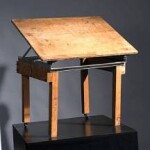 David mentioned that he and his wife had acquired all the furniture with the cottage. Mrs. Leslie had told him that it included a work desk and other items purchased by Steinbeck. I was most curious about a table-top draftsman’s board manufactured by Admel Drafting Equipment and supplied by Lawes Rabjohns Ltd. of Westminster. On our return to California, I found several references to the table in Steinbeck’s correspondence with Chase Horton. On April 25, 1959, he wrote, “My table-top tilt board came. Makes a draftsman’s table of a card table. My neck and shoulders don’t get so damned tired.” I contacted Betty Guy in San Francisco to ask if she had noticed a table when she was invited to the writer’s room to sketch from the window. She said she had: “When John asked me up to his room he showed me his slanted work table, so it must have been the draftsman’s table.” I was delighted to learn that this was the table upon which a literary giant crafted his evocative letters extolling the joys of “the time at Discove” all those decades ago. Steinbeck’s work table is currently on display in the Bruton Museum.
David mentioned that he and his wife had acquired all the furniture with the cottage. Mrs. Leslie had told him that it included a work desk and other items purchased by Steinbeck. I was most curious about a table-top draftsman’s board manufactured by Admel Drafting Equipment and supplied by Lawes Rabjohns Ltd. of Westminster. On our return to California, I found several references to the table in Steinbeck’s correspondence with Chase Horton. On April 25, 1959, he wrote, “My table-top tilt board came. Makes a draftsman’s table of a card table. My neck and shoulders don’t get so damned tired.” I contacted Betty Guy in San Francisco to ask if she had noticed a table when she was invited to the writer’s room to sketch from the window. She said she had: “When John asked me up to his room he showed me his slanted work table, so it must have been the draftsman’s table.” I was delighted to learn that this was the table upon which a literary giant crafted his evocative letters extolling the joys of “the time at Discove” all those decades ago. Steinbeck’s work table is currently on display in the Bruton Museum.
This article has been adapted by the author from a version originally published in the Fall 2006 issue of Steinbeck Review. Unless otherwise noted, all quotations attributed to Steinbeck are from The Acts of King Arthur and his Noble Knights, ed. Chase Horton (New York: Farrar, Straus and Giroux, 1976), and Steinbeck: A Life in Letters, ed. Elaine Steinbeck and Robert Wallsten (New York: Viking, 1975).
East of Eden: A Pilgrimage in Pictures to John Steinbeck’s Salinas, California
East of Eden, the autobiographical novel John Steinbeck described as his “marathon book,” portrayed Salinas, California at the turn of the 20th century as a small place with big problems. Steinbeck characterized the culture of the town where he was born in 1902 even more critically in “Always Something to Do in Salinas,” an essay he wrote for Holiday Magazine three years after completing East of Eden. His description of Salinas sins and shortcomings in “L’Affaire Lettuceburg” was so negative that he recalled the manuscript and prevented its publication. Eventually Salinas forgave the injury, naming the town library in Steinbeck’s honor and building a center devoted to his life and work on Main Street. But main street Salinas, California fell on hard times after John Steinbeck left, the victim of suburban sprawl and competition from Monterey, Carmel, Pebble Beach, and Pacific Grove, where Steinbeck preferred to live and write. With this in mind, I made a pilgrimage with my camera to record changes in Salinas since East of Eden and to discover how Steinbeck is remembered today, almost 50 years after his death.
John Steinbeck’s Salinas, California Starts on Main Street
I started at the National Steinbeck Center, built 18 years ago at One Main Street to house the John Steinbeck archive, attract visitors, and educate residents about the town’s most famous son. Inside, I relived scenes from East of Eden and other works through video clips, stage sets, and documents about Steinbeck’s boyhood in Salinas. Guided by Steinbeck’s words—and by murals, plaques, and signs memorializing his life—I set out to explore the links to the past provided by buildings that survive from Steinbeck’s era.
Guided by Steinbeck’s words—and by murals, plaques, and signs memorializing his life—I set out to explore the links to the past provided by buildings that survive from Steinbeck’s era.
Seen from the center’s front steps, Steinbeck’s craggy visage dominates the mural on the building across Central Avenue where the grocer and butcher patronized by his mother did business 100 years ago. Looking down Main Street, I saw Mount Toro, the backdrop for The Pastures of Heaven, the stories about trouble in paradise written by Steinbeck 20 years before East of Eden. Mentally uprooting trees and planters and replacing sleek SUVs with boxy black Fords, I tried to imagine Main Street as it appeared to Steinbeck when he was writing his stories. The effort was complicated by a pair of modern structures built to bring people back to town: the Maya Cinema multiplex and the world headquarters of Taylor Farms, edifices that face one another, literally and symbolically, across the Main Street divide.
Life Along John Steinbeck’s Central Avenue Then and Now
From One Main Street I retraced the steps of Adam Trask, who in East of Eden “turned off Main Street and walked up Central Avenue to number 130, the high white house of Ernest Steinbeck.” Today the Central Avenue home where John Steinbeck was born is number 132, and the white exterior of Steinbeck’s era has been replaced by cream, blue, and tan tones highlighting the Queen Anne-style frills and furbelows. Inside, high ceilings, dark polished wood, and Victorian decor greet lunch patrons at the Steinbeck House restaurant, operated by the nonprofit organization that purchased the home after it passed through stages of ownership and decay following the death of Steinbeck’s father in 1935.
Today the Central Avenue home where John Steinbeck was born is number 132, and the white exterior of Steinbeck’s era has been replaced by cream, blue, and tan tones highlighting the Queen Anne-style frills and furbelows.
A Steinbeck House volunteer greeted me in the room where the writer was born; the maternal bed, a finely crafted period piece, can be seen in the gift shop downstairs. I dined next to the fireplace where Olive Steinbeck, a schoolteacher, nourished John and his three sisters on a diet of classical music and great books that fed the imagination of the budding author, who observed life on Central Avenue from the gable window of his bedroom. “I used to sit in that little room upstairs,” he recalled, “and write little stories.” Parts of The Red Pony and Tortilla Flat were written while Steinbeck tended his mother at home before her death in 1934. “The house in Salinas is pretty haunted now,” he confided to a friend. “I see things walking at night that it is not good to see.”
Olive Steinbeck, a schoolteacher, nourished John and his three sisters on a diet of classical music and great books that fed the imagination of the budding author, who observed life on Central Avenue from the gable window of his bedroom.
A block away, Steinbeck spent happy hours playing with the Wagner brothers, whose mother Edith, an aspiring writer in whom Steinbeck confided his own ambition, provided material for Steinbeck’s story “How Edith McGillicuddy Met R. L. S.” One brother was involved in the throwing of a roast beef through the glass door of city hall, an act attributed to Steinbeck, who recalled that “[Max] worked so hard and I got all the credit.” Steinbeck and the Wagner boys eventually made their way to Hollywood, where Jack helped with script writing for the film adaptation of Steinbeck’s short novel The Pearl. Max, an actor, played bit parts in movie versions of The Grapes of Wrath and The Red Pony. Jack recruited Steinbeck to help with screenwriting for the 1945 motion picture A Medal for Benny. Max also participated.
In Trouble as a Boy and as a Man in Salinas, California
At 120 Capitol Street, not far from Central Avenue, Roosevelt Elementary School replaced the grammar school that John Steinbeck and the Wagner brothers attended. The school is depicted somberly in East of Eden (“the windows were baleful; and the doors did not smile”) and in the journal Steinbeck kept while writing the novel (“I remember how grey and doleful Monday morning was. . . . What was to come next I knew, the dark corridors of the school”). Steinbeck’s ambivalent feelings about schooldays in Salinas failed to improve with time. Once he was famous, he objected to the idea of naming a school in his honor: “If the city of my birth should wish to perpetuate my name clearly but harmlessly, let it name a bowling alley after me or a dog track or even a medium price, low-church brothel – but a school – !”
Steinbeck’s ambivalent feelings about schooldays in Salinas failed to improve with time.
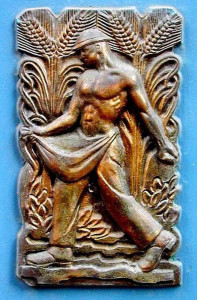 Unlike his pals up the street, John Steinbeck’s parents respected the social and political order of Salinas, the seat of Monterey County. Steinbeck’s father served as county treasurer, and law-abiding pioneer faces stare down from the walls of the town’s Art Moderne courthouse today. Like bas-relief marble panels and bronze door embellishments that celebrate the agricultural workers immortalized in Steinbeck’s fiction, they are the work of Joe Mora, a WPA artist. Steinbeck gathered material for East of Eden at the Art Moderne newspaper building across the street; he played basketball and attended his senior prom at the nearby Troop C Armory building, “where men over fifty . . . snapped orders at one another and wrangled eternally about who should be officers.”
Unlike his pals up the street, John Steinbeck’s parents respected the social and political order of Salinas, the seat of Monterey County. Steinbeck’s father served as county treasurer, and law-abiding pioneer faces stare down from the walls of the town’s Art Moderne courthouse today. Like bas-relief marble panels and bronze door embellishments that celebrate the agricultural workers immortalized in Steinbeck’s fiction, they are the work of Joe Mora, a WPA artist. Steinbeck gathered material for East of Eden at the Art Moderne newspaper building across the street; he played basketball and attended his senior prom at the nearby Troop C Armory building, “where men over fifty . . . snapped orders at one another and wrangled eternally about who should be officers.”
Steinbeck’s father served as county treasurer, and law-abiding pioneer faces stare down from the walls of the town’s Art Deco-style courthouse today.
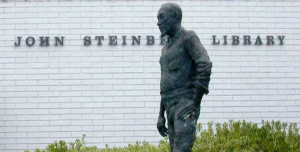 Like Main Street viewed from the National Steinbeck Center, Lincoln Avenue in downtown Salinas is dominated by an imposing image of John Steinbeck, this in the form of the life-size statue installed outside the public library that now bears Steinbeck’s name. Inside the modest brick building I browsed the wealth of Steinbeck books, articles, and clippings accumulated over decades by scholars, friends, and fans. Steinbeck wasn’t always popular with librarians or readers, however. According to Dennis Murphy, the son of a Steinbeck friend and neighbor, angry locals burned copies of The Grapes of Wrath at the corner of San Luis and Main Street. The venue for their act of rage was the Carnegie Library, since torn down, where according to Steinbeck, an unsympathetic librarian “remarked that it was lucky my parents were dead so that they did not have to suffer this shame.”
Like Main Street viewed from the National Steinbeck Center, Lincoln Avenue in downtown Salinas is dominated by an imposing image of John Steinbeck, this in the form of the life-size statue installed outside the public library that now bears Steinbeck’s name. Inside the modest brick building I browsed the wealth of Steinbeck books, articles, and clippings accumulated over decades by scholars, friends, and fans. Steinbeck wasn’t always popular with librarians or readers, however. According to Dennis Murphy, the son of a Steinbeck friend and neighbor, angry locals burned copies of The Grapes of Wrath at the corner of San Luis and Main Street. The venue for their act of rage was the Carnegie Library, since torn down, where according to Steinbeck, an unsympathetic librarian “remarked that it was lucky my parents were dead so that they did not have to suffer this shame.”
Edifices in East of Eden and The Winter of Our Discontent
Some Main Street storefronts are now covered by stucco facades. The surface of one, a six-story bank at the corner of East Alisal and Main Street, is faced with Art Deco terracotta tiles; others hold memories that were painful to John Steinbeck and his family. Ernest Steinbeck’s fledgling feed store at 332 Main Street failed when cars replaced horses. “Poor Dad couldn’t run a store,” Steinbeck wrote in his journal—“he didn’t know how.” Steinbeck fictionalized the failure of his father’s store in The Winter of our Discontent, the semi-autobiographical novel he set in Sag Harbor, New York, a small town that feels like early 20th century Salinas when you read the book now.
Steinbeck fictionalized the failure of his father’s store in the semi-autobiographical novel he set in Sag Harbor, New York, a small town that feels like early 20th century Salinas when you read the book now.
At the Cherry Bean Coffee Shop, a thriving concern occupying part of the site where Ernst Steinbeck opened his store, I dallied over a “Steinbeck brew” and listened to regulars discuss issues of the day, just as Steinbeck did at the main street Sag Harbor coffee shop when he was writing The Winter of Our Discontent. As noted in “L’Affaire Lettuceburg,” Salinas was less democratic in Steinbeck’s time, with “cattle people” at the top of the social stratification he satirized in “Always Something to Do in Salinas.” “Sugar people joined Cattle People in looking down their noses” at lettuce-growers, he recalled in 1955. “These Lettuce People had Carrot People to look down on and these in turn felt odd about associating with Cauliflower People.” Today, complaints heard at the Coffee Bean Shop on Main Street in Salinas revolve around “Silicon People,” commuters with high-paying tech jobs who are inflating home prices.
Salinas was less democratic in Steinbeck’s time, with “cattle people” at the top of the social stratification he satirized in “Always Something to Do in Salinas.”
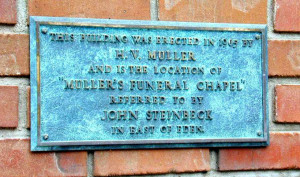 Muller’s Funeral Chapel, another East of Eden landmark, is commemorated with a plaque dedicated to H.V. Muller at 315 Main Street, where John Steinbeck’s mother was prepared for burial in 1934. Today a beauty parlor occupies the space at 242 Main Street where Bell’s Candy Store stood back in 1917, when Steinbeck was a teenager and “the rage was celery tonic.” According to the proprietor at the time, “John was a good boy, but you had to keep your eye on him around the candy!” Across Main Street from Bell’s, Of Mice and Men played at the Exotic Fox Californian Theater when the movie—the first ever made from a book by Steinbeck—opened in 1939.
Muller’s Funeral Chapel, another East of Eden landmark, is commemorated with a plaque dedicated to H.V. Muller at 315 Main Street, where John Steinbeck’s mother was prepared for burial in 1934. Today a beauty parlor occupies the space at 242 Main Street where Bell’s Candy Store stood back in 1917, when Steinbeck was a teenager and “the rage was celery tonic.” According to the proprietor at the time, “John was a good boy, but you had to keep your eye on him around the candy!” Across Main Street from Bell’s, Of Mice and Men played at the Exotic Fox Californian Theater when the movie—the first ever made from a book by Steinbeck—opened in 1939.
Today a beauty parlor occupies the space at 242 Main Street where Bell’s Candy Store stood back in 1917, when Steinbeck was a teenager and “the rage was celery tonic.”
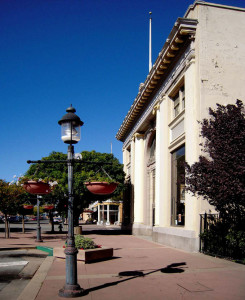 Generations of agricultural wealth in Salinas, California built banks at the four corners of Gavilan and Main streets and held strong views about John Steinbeck. Reporting on local reaction to The Grapes of Wrath, Steinbeck wrote: “The vilification of me out here from the large landowners and bankers is pretty bad.” Today the four banks are gone and food and antiques are sold in temples where money was once dispensed in an attitude of quiet reverence captured by Steinbeck in East of Eden. Cal withdraws 15 crisp new thousand-dollar bills, and Kate deposits her whorehouse earnings, in the Monterey County Bank building at 201 Main Street. The vaulting structure, recently restored, may also have been the inspiration for the cathedral-like bank that Ethan Hawley decides to rob in The Winter of Our Discontent. Forty years after Steinbeck’s last novel, it served as the location for Bandits, a movie starring Bruce Willis.
Generations of agricultural wealth in Salinas, California built banks at the four corners of Gavilan and Main streets and held strong views about John Steinbeck. Reporting on local reaction to The Grapes of Wrath, Steinbeck wrote: “The vilification of me out here from the large landowners and bankers is pretty bad.” Today the four banks are gone and food and antiques are sold in temples where money was once dispensed in an attitude of quiet reverence captured by Steinbeck in East of Eden. Cal withdraws 15 crisp new thousand-dollar bills, and Kate deposits her whorehouse earnings, in the Monterey County Bank building at 201 Main Street. The vaulting structure, recently restored, may also have been the inspiration for the cathedral-like bank that Ethan Hawley decides to rob in The Winter of Our Discontent. Forty years after Steinbeck’s last novel, it served as the location for Bandits, a movie starring Bruce Willis.
Main Street South to John Steinbeck’s Final Destination
Returning to my car, I left Main Street and turned onto Market (formerly Castroville) Street, the setting for several scenes in East of Eden. “Two blocks down the Southern Pacific tracks cut diagonally,” Steinbeck recalls in the novel: “Over across the tracks down by Chinatown there’s a row of whorehouses.” Driving to the Garden of Memories Memorial Park west of town, I found the simple bronze plaque marking Steinbeck’s final resting place, the end point of my pilgrimage to Salinas, California. Nearby, major players in Steinbeck’s life and fiction—including his wife Elaine, his grandfather Sam Hamilton, and the aunts and uncles celebrated in East of Eden—cohabit peacefully in “that dear little town” where the imagination and conscience of John Steinbeck were kindled a century ago.
This is an updated version of an article published in the Fall 2001 issue of Steinbeck Studies. Our thanks to Carol Robles for correcting several factual errors introduced in the editing process. The Garden of Memories, located southeast of downtown Salinas, contains more than one Hamilton family plot. The headstone shown here is not the one marking the site of John Steinbeck’s ashes. The burning of The Grapes of Wrath in Salinas is attested in various sources, including an interview with the writer Dennis Murphy, the grandson of the Salinas physician who treated Steinbeck as a boy. The Murphy interview is one of a number available to Steinbeck scholars and students in the National Steinbeck Center archive.—Ed.
“The Valley of the World”: John Steinbeck’s Salinas Valley in Color Photography Inspired by East of Eden
More than 60 years after it became a national bestseller, John Steinbeck’s novel East of Eden remains one of the writer’s most widely read works of fiction. Set in California’s Salinas Valley, where the author grew up and is buried, East of Eden recreates a turbulent era in American life, the period from the Civil War to World War I, through two generations of a pair of Salinas Valley families whose individual lives intersect dramatically during an era characterized by change and conflict in the Salinas Valley and on the world stage. In describing the novel’s setting as “the valley of the world,” John Steinbeck clearly meant East of Eden to be read as allegory, like the Old Testament story mirrored in its title, and as autobiography—intended, he said, for his two young sons, growing up far from the Salinas Valley after World War II. In 2010, the Steinbeck scholar Michael J. Meyer asked David A. Laws, a gifted photographer known for his bright images of John Steinbeck’s Salinas Valley, to take a series of photos to illustrate a book of literary essays on East of Eden. Meyer died in 2011, but the process of collecting and editing essays by various scholars of John Steinbeck was picked up and completed by Henry Veggian, a professor at the University of North Carolina at Chapel Hill. The result was East of Eden: New and Recent Essays, published by Editions Rodopi (now Brill) in 2013 and reviewed here.—Ed.
Images of the Salinas Valley Inspired by East of Eden
My contribution to East of Eden: New and Recent Essays appeared as a black-and-white photo essay—“Literary Landmarks of East of Eden”—comprised of 15 images that I look of locations around the Salinas Valley inspired by passages from John Steinbeck’s epic novel. The text I wrote remains the copyright of Rodopi, but I retained ownership of the following images, published here for the first time from my original color files. Although much has changed since John Steinbeck returned to his hometown in the early 1950s to recall the “sights and sounds, smells and colors” of the Salinas Valley that fill East of Eden, and even more since Adam Trask arrived in search of his own Eden, these images are recent examples of the scenes and settings that informed the author and that continue to convey the essence of those times. Page references quoting the novel are from the edition of East of Eden published by Penguin Books in 2002, John Steinbeck’s centennial.—David A. Laws
“I would like to write the story of this whole valley, of all the little towns and all the farms and ranches in the wilder hills.”—Steinbeck: A Life in Letters, ed. Elaine Steinbeck and Robert Wallsten (Penguin Books, 1976), p. 73
“The river mouth at Moss Landing was centuries ago the entrance to this long inland water.”—East of Eden, p. 4
“Then the hard, dry Spaniards came exploring through, greedy and realistic. . . . Of course they were religious people, and the men who could read and write, who kept the records and drew the maps, were the tough untiring priests who traveled with the soldiers.”—East of Eden, p. 6
“There were no springs, and the crust of topsoil was so thin that the flinty bones stuck through. Even the sagebrush struggled to exist, and the oaks were dwarfed from lack of moisture.”—East of Eden, p. 9
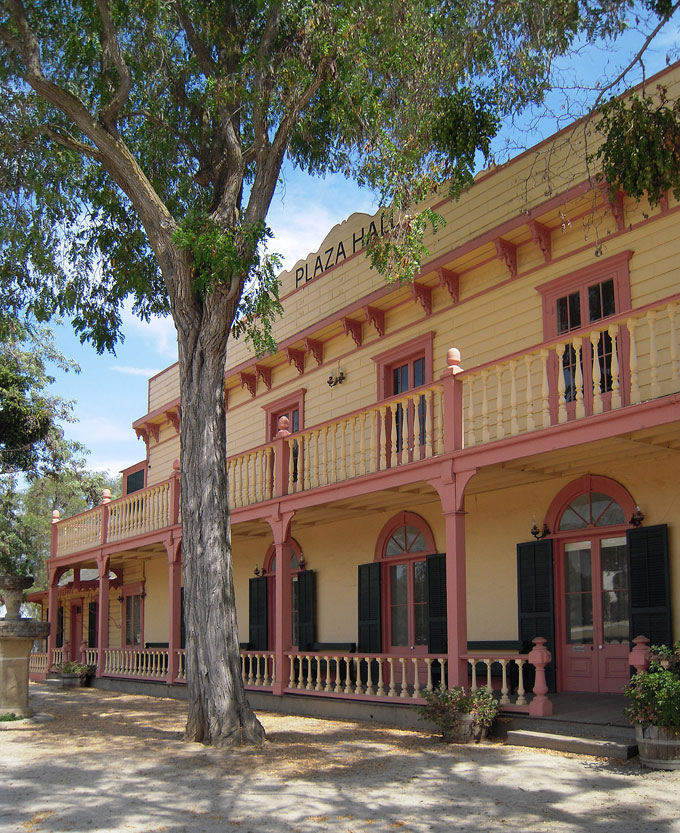
The Plaza Hall in San Juan Bautista played the role of the King City hotel in the 1981 “East of Eden” TV mini-series.
“One morning she complained of feeling ill and stayed in her room in the King City hotel while Adam drove into the country. He returned about five in the afternoon to find her nearly dead from loss of blood.”—East of Eden, p. 133
“Later Samuel and Adam walked down the oak-shadowed road to the entrance to the draw where they could look out at the Salinas Valley.”—East of Eden, p. 293
“They left the valley road and drove into the worn and rutted hills over a set of wheel tracks gullied by the winter rains. The horses strained into their collars and the buckboard rocked and swayed. The year had not been kind to the hills, and already in June they were dry.”—East of Eden, p. 137
“’This will be a valley of great richness one day. It could feed the world, and maybe it will.’”—East of Eden, p. 145
“In the country the repository of art and science was the school, and the schoolteacher shielded and carried the torch of learning and of beauty. The schoolhouse was the meeting place for music, for debate. The polls were set in the schoolhouse for elections. Social life, whether it was the crowning of a May queen, the eulogy to a dead president, or an all-night dance, could be held nowhere else.”—East of Eden, p. 146
“’I don’t know whether you noticed, but a little farther up the valley they’re planting windbreaks of gum trees. Eucalyptus—comes from Australia. They say the gums grow ten feet a year.’”—East of Eden, p. 164
“At eight-thirty on a Wednesday morning Kate walked up Main Street, climbed the stairs of the Monterey County Bank Building, and walked along the corridor until she found the door which said, ‘Dr. Wilde—Office Hours 11-2.’”—East of Eden, pp. 240-241
“The traditional dark cypresses wept around the edge of the cemetery, and white violets ran wild in the pathways. . . . The cold wind blew over the tombstones and cried in the cypresses.”—East of Eden, p. 309
“The ‘dobe house had entered its second decay. The great sala all along the front was half plastered, the line of white halfway around and then stopping, just as the workmen had left it ten years before. . . . A smell of mildew and of wet paper was in the air.”—East of Eden, pp. 342-343
“When Adam left Kate’s place he had over two hours to wait for the train back to King City. On an impulse he turned off Main Street and walked up Central Avenue to number 130, the high white house of Ernest Steinbeck. It was an immaculate and friendly house, grand enough but not pretentious, and it sat inside its white fence, surrounded by its clipped lawn, and roses and catoneasters lapped against its white walls.”—East of Eden, p. 382
“It’s a pleasant little stream that gurgles through the Alisal against the Gabilan Mountains on the east of the Salinas Valley. The water bumbles over round stones and washes the polished roots of the trees that hold it in.”—East of Eden, p. 589
John Steinbeck Inspires Monterey County Visual Arts Masters, Past and Present
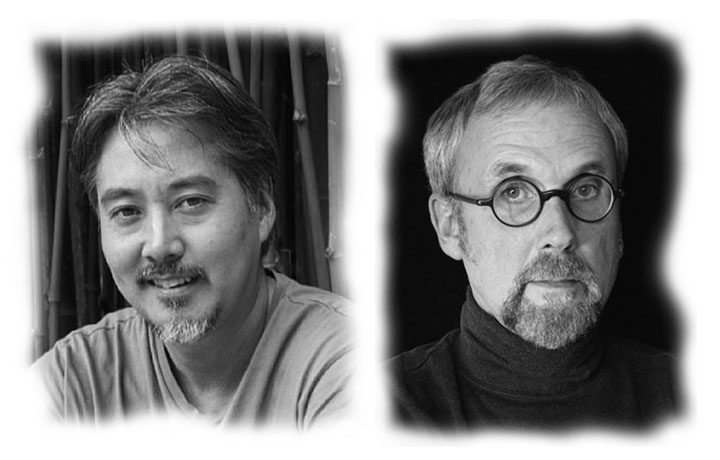 The rugged coast and majestic mountains of Monterey County, California, inspired awe-struck visual arts professionals and amateurs long before John Steinbeck appeared on the scene. So it seems natural that Steinbeck, born and raised in Monterey County, was attracted to the visual arts and met well-known artists of the period, such as E. Charlton Fortune and Armin Hansen, California Impressionist painters who lived and created much of their most popular work in Monterey County.
The rugged coast and majestic mountains of Monterey County, California, inspired awe-struck visual arts professionals and amateurs long before John Steinbeck appeared on the scene. So it seems natural that Steinbeck, born and raised in Monterey County, was attracted to the visual arts and met well-known artists of the period, such as E. Charlton Fortune and Armin Hansen, California Impressionist painters who lived and created much of their most popular work in Monterey County.
Writing in and about Monterey County in the 1930s and 40s, Steinbeck befriended a host of younger artists who were, like the author, perfecting their craft in the company of colleagues, friends, and lovers. But the ripening John Steinbeck-Monterey County-visual arts connection didn’t end with the author’s death. Forty-five years later it continues in the work of contemporary Monterey County painters including Warren Chang (above left) and David Ligare (above right), successful artists who differ in technique but share a source of inspiration in the literary landscapes of John Steinbeck.
John Steinbeck and the Visual Arts in Monterey County
Steve Hauk—the Monterey County writer and art dealer who co-curated This Side of Eden – Images of Steinbeck’s California, the inaugural exhibition of the National Steinbeck Center in Salinas—is an expert on John Steinbeck and the visual arts, past and present, in Monterey County. He was interviewed for films on E. Charlton Fortune and on John Steinbeck and his Monterey County artist circle for the 100-Story Project, an archival narrative of Monterey County history and culture. Among the best known members of Steinbeck’s circle were several artists—notably James Fitzgerald, Ellwood Graham, Judith Deim, and Bruce Ariss—who created notable portraits of the author, a shy person who enjoyed being painted but didn’t like to be photographed.
John Steinbeck also befriended artists beyond Monterey County. Among his closest confidantes was Bo Beskow, the Swedish painter who completed portraits of the author at Steinbeck’s request in the 1940s, 50s, and 60s. The American painter Thomas Hart Benton, whose perspective on his native Midwest mirrored Steinbeck’s passion for Monterey County, never met the writer but shared his populist politics and anti-elitist aesthetics. Benton’s illustrations for a special edition of The Grapes of Wrath captured the book’s spirit so well that the writer and the artist became synonyms for sentimentality among critics of their work.
Today the Canadian painter Ron Clavier continues the John Steinbeck-visual arts tradition beyond Monterey County in paintings that portray passages from The Grapes of Wrath. A neuropsychologist by training, Clavier unites science and the visual arts in painting that would have appealed strongly to Steinbeck’s sense of unity, universality, and nature. “As a visual artist,” says Clavier, “I dream that I might replicate the magnificent imagery of the world, and by doing so, remind others of their own core decency,” adding that “each day, I try to experience what American author and Nobel Laureate John Steinbeck described as awe, humility, and joy.”
The Visual Arts in Action: Warren Chang and David Ligare
David Ligare and Warren Chang are leading examples of contemporary Monterey County artists whose work reflects Steinbeck’s empathy for the dispossessed and the author’s love of the Monterey County landscape. River/Mountain/Sea—Ligare’s current exhibition at the Monterey Museum of Art—is a compelling example of the John Steinbeck-Monterey County-visual arts phenomenon that has made Monterey County a mecca for aficionados of the visual arts and Steinbeck fans alike. Similarly, Warren Chang’s 2012 ten-year retrospective at the Pacific Grove Art Center shows the inspiration provided by Steinbeck’s rich human material—in Chang’s case, Steinbeck’s stories of marginalized Monterey County farm workers, a major subject of the author’s early writing.
Like John Steinbeck’s fiction, the paintings of David Ligare and Warren Chang are technically superb, thematically coherent, and emotionally riveting. While acknowledging Steinbeck’s impact on the development of their very different versions of visual-arts realism, each also notes the influence of European classicism in their work. Chang’s style owes much to the paintings of Jean-Francois Millet, Rembrandt, and Vermeer. Ligare notes the rules of visual arts structure exemplified by Nicolas Poussin as an influence, along with classical art and literature—a lifelong interest of John Steinbeck, who acknowledged the role of Greek and Roman authors in his literary development, as Ligare does in the visual arts.
Like Steinbeck, Chang portrays the pain of the human condition and the triumph of the human spirit: his paintings of farm workers toiling in Monterey County fields depict disenfranchised members of modern society, as Steinbeck did in his most memorable fiction of the 1930s. By contrast, Ligare’s Monterey County landscapes are devoid of human artifact or activity, relying on dramatic lighting and carefully crafted composition to suggest the tension and complexity beneath the pastoral surface. Steinbeck achieved a similar effect with words, notably the extended description of the Salinas Valley that opens East of Eden, as well as the stories, letters, and essays in which he described the Salinas of his boyhood as a placid town with an undertone of evil.
Warren Chang’s Stories on Canvas
Chang was born and raised in Monterey County and attended the Art Center College of Design in Pasadena, California, where he received his BFA in illustration in 1981. After working as an award-winning illustrator in California and New York, he eventually returned to Monterey and transitioned to an equally successful career as a fine artist. Today he is one of only 50 artists recognized as a Master Signature member of Oil Painters of America.
Chang’s portfolio features interior and landscape subjects including portraits, still-life paintings, and scenes from his home, studio, and the San Francisco Academy of Art University classroom where he teaches. As Steinbeck observed, the visual arts, like literature, can tell dramatic stories that draw viewers into the picture—a truth demonstrated in Chang’s Monterey County landscapes, where a single moment captured on canvas suggests the ongoing narrative of which it is a part. Chang’s paintings of Monterey County field workers have been compared to the Flemish master Pieter Bruegel the Elder. Examples from Warren Chang Narrative Paintings (Flesk Publications, 2012) are shown here with the permission of the artist, whose paintings can also be seen at Hauk Fine Arts in Pacific Grove and at the Winfield Gallery in nearby Carmel. (For more information, visit Chang’s website.)
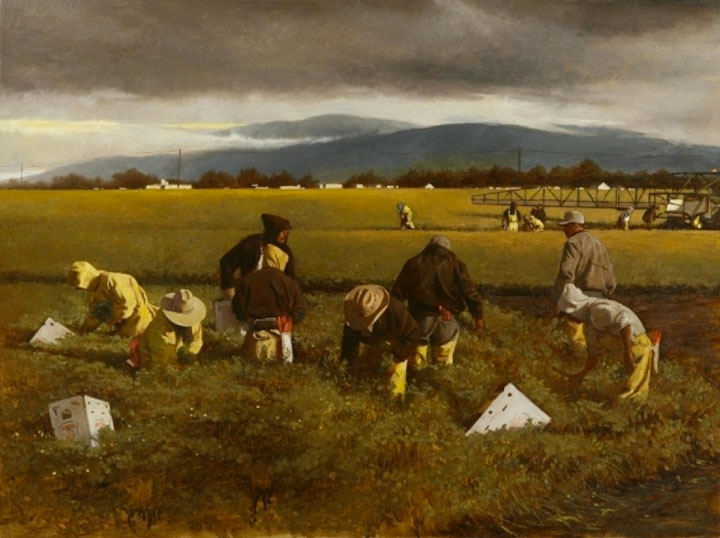
Approaching Storm
Oil on canvas by Warren Chang, 30” x 40” (2006)
Courtesy of the artist. ©Warren Chang
Approaching Storm is a dramatic study of Monterey County workers hurrying to complete the broccoli harvest before an unseasonable storm that could destroy the crop and their livelihood. Agriculture is a major Monterey County industry: the fields dotting Monterey County’s coastline and valleys produce lettuce, broccoli, and artichokes in abundance.
Day’s End portrays laborers leaving the artichoke fields near the Monterey County town of Castroville at the end of the work day. John Steinbeck, who worked alongside migrant laborers as a young man, conveyed the mood and feeling of Monterey County’s farm fields in carefully chosen words. Chang accomplishes the same purpose through deep shadows and late afternoon lighting rendered in subdued colors.
Fall Tilling recently won Best of Show in the 2013 RayMar Fine Art Competition. Except for the cell phone and Coke clutched by the female figure in the foreground of the painting, this characteristic Monterey County scene could have been painted using the same essential elements—mountains, fields, workers—at any time in the past 200 years. Chang’s reply to a question about the meaning of his works could have come from John Steinbeck, a writer who demurred when asked about the meaning of his books. “No one interpretation is necessarily more accurate than another,” says Chang. “You have the freedom to take from each painting what you will.” Ut pictura poesis: the visual arts, like literature, create images that invite us to draw our own conclusions.
David Ligare’s Paintings from the Pastures of Heaven
Unlike John Steinbeck and Warren Chang, David Ligare is not a Monterey County native. Born in Oak Park, Illinois, he traveled to Los Angeles to study at the Art Center College of Design. From there—inspired, he recalls, by the writings of John Steinbeck and Robinson Jeffers—he moved to Monterey County, where he lived and worked in a small house on the Big Sur coastline, experimenting “as young artists do, with new styles and concepts.”
Ligare’s experimentation led to a distinctive style that he describes as “Post-Modern, Neo-Classical American,” weaving contemporary retelling of Greek myths into landscapes that are instantly familiar to Monterey County residents. His paintings have appeared in numerous solo exhibitions and can be found in the collections of New York’s Museum of Modern Art, the Fine Arts Museums of San Francisco, the Gabinetto Disegni e Stampe degli Uffizi in Florence, and the Thyssen-Bornemisza Museum of Art in Madrid.
The following examples of the artist’s work span the period from 1988 to the present and are shown with the artist’s permission. Several recent paintings appear in River/Mountain/Sea, the exhibition showing at the Monterey Museum of Art through April 27, 2014. Others can be viewed at the Hirschl & Adler Modern Gallery in New York and at the Winfield Gallery in Carmel. (For more information, visit Ligare’s website.)
In “John Steinbeck and the Pastoral Landscape: An Artist’s Viewpoint,” a lecture delivered in 2002 at the National Steinbeck Center, Ligare explained his purpose: “I have basically made a career of pulling the past into the present.” Landscape with a Man Drinking from a Spring is set in the Gabilan Mountains, not far from the site of Steinbeck’s novella The Red Pony. Ligare’s depiction of “a celebration of a wholesomeness that embraces both life and death”—a pervasive theme of Greek and Roman writing—shares two key symbols with Steinbeck’s description of the boy Jody, drinking from a mossy tub on the Tiflin Ranch, in the first part of The Red Pony. In both painting and story, the clear spring represents life while the cypress tree beneath which Carl Tiflin slaughters his pigs signifies death, unavoidable and often dirty.
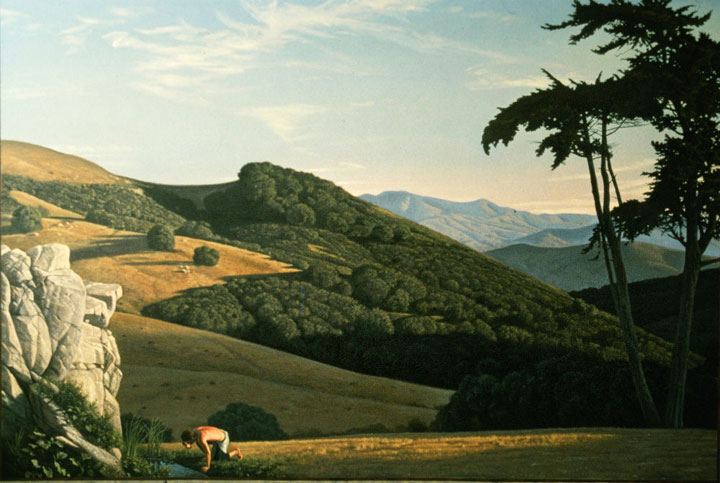
Landscape with a Man Drinking from a Spring
Oil on canvas by David Ligare, 60 x 90 (1988)
Courtesy of the artist. ©David Ligare
After Ligare moved to Monterey County’s Corral de Tierra, the setting of John Steinbeck’s novel The Pastures of Heaven, the Monterey County landscape emerged from the background to dominate his paintings. David Ligare, a catalog published by the Hackett-Freedman Gallery in 1999, contains nine plates; six are panoramic views of Steinbeck’s heavenly valley by the artist that could easily serve as illustrations for the novel. The subject of the catalog’s cover illustration—Landscape with a Red Pony—refers to Steinbeck’s story of adolescent initiation in rural Monterey County, written when the struggling author and his wife Carol were intimately involved with Monterey County’s Depression-era visual arts scene.
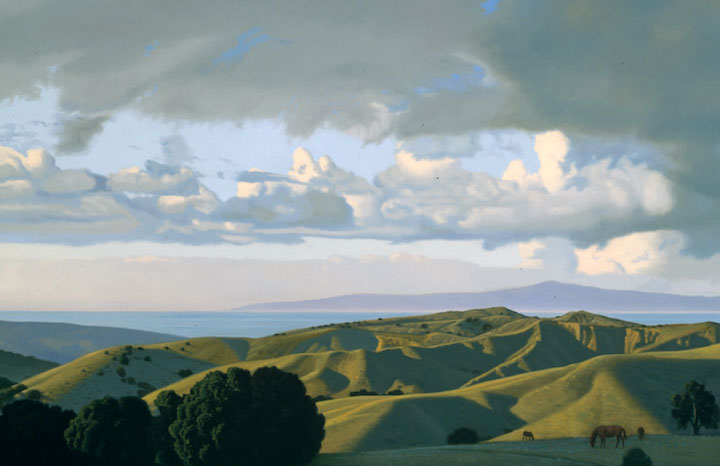
Landscape with a Red Pony
Oil on canvas by David Ligare, 32” x 48” (1999)
Courtesy of the artist. ©David Ligare
Ligare explains why he likes to paint in the “golden hour” of the late Monterey County afternoon: “No matter whether I’m painting a simple rock or a figure in a landscape or a still life, it’s important to me to use the late afternoon sunlight and to create a sense of wholeness by recognizing all of the direct and indirect light sources. Everything in nature is a reflection in one way or another of everything around it.”
River is one of three monumental paintings in the River/Mountain/Sea exhibition created by the artist in homage to his adopted Monterey County. Like Mountain and Sea, it represents an iconic Monterey County location featured in Steinbeck’s fiction. Ligare’s river scene shows the Salinas River as it emerges from the valley’s mouth into its broad agricultural plain. Mountain depicts majestic Mount Toro and Castle Rock—the rock formation that fired John Steinbeck’s boyhood imagination—as shadows fill the folds on Mount Toro’s western flank. In Sea, the third painting, granite tidal rocks are lit by the last rays of the evening sun near Lover’s Point in Pacific Grove.
Visiting Monterey County? Don’t Miss Masters in Miniature
Miniatures, the Monterey Museum of Art’s annual holiday exhibition and fundraiser, features 300 paintings, photographs, prints, sculptures, and mixed media works contributed by Monterey County artists for purchase through the sale of raffle tickets. Paintings by David Ligare and Warren Chang are among the most highly sought-after works featured at the event each year. Chang and Ligare’s 2013 offerings capture the essence of their art in the 7 x 9 inch-limit format mandated by the museum for paintings contributed to the show: Ligare’s Pinax, a meticulously rendered image of a Monterey County pine cone on a polished pine wood mount, refers to Dionysus, the Greek god of wine who sported a pine cone on top of his staff. Chang’s Master Study of Velazquez’s “The Fable of Arachne” displays the artist’s trademark use of highlights and shadows in an intimate portrait of a woman winding a ball of wool. Miniatures is open through December 31. If you’re visiting Monterey County during the holidays, don’t miss it.
Photo of Warren Chang by Sonya Chang, courtesy of Warren Chang. Photo of David Ligare courtesy of David Ligare.
John Steinbeck Celebrated in Old and New Public Art
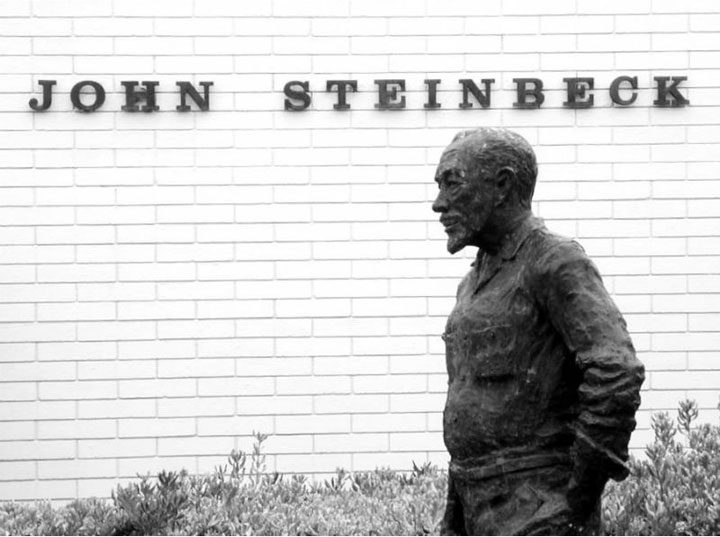 Salinas and Monterey—the two cities most closely associated with John Steinbeck and his California stories—both celebrate the life and work of the writer though a variety of public art projects. Although few of the murals and sculptures along Cannery Row in Monterey or in Steinbeck’s home town of Salinas approach the level of fine art, they enhance their surroundings while serving social, educational, and sponsorship interests in Steinbeck Country. When Steinbeck lovers visit, most view the works in a spirit of understanding.
Salinas and Monterey—the two cities most closely associated with John Steinbeck and his California stories—both celebrate the life and work of the writer though a variety of public art projects. Although few of the murals and sculptures along Cannery Row in Monterey or in Steinbeck’s home town of Salinas approach the level of fine art, they enhance their surroundings while serving social, educational, and sponsorship interests in Steinbeck Country. When Steinbeck lovers visit, most view the works in a spirit of understanding.
The tradition of spreading political and religious messages through large-scale mural paintings originated with the Olmec civilization, the first major civilization in Mexico, and continued through the Spanish Colonial period to the time of the Mexican Revolution and beyond. With a current Hispanic population approaching 75 per cent, it is not surprising that mural representations of Steinbeck and his works are found in the City of Salinas. Thanks to financial support from the Cannery Row Company, works of sculpture predominate in nearby Monterey. Best of all, new art inspired by Steinbeck continues to be produced.
John Steinbeck Murals in Downtown Salinas
Public agencies have played a role, funding the One Voice Murals Project to develop community pride and provide summer work experience for youth throughout Monterey County. Of more than a dozen large-scale murals from Castroville to Greenfield funded by the One Voice Project Arts & Leadership Project, four of the finished pieces—all in Salinas—portray Steinbeck-related themes.
With the help of eight young painters in 1998, supervising muralists Patrizia Johnson and Mel Mathewson created the mural that has become familiar to visitors to the National Steinbeck Center. Dominated by a portrait of the bearded writer, the work is comprised of a collage of images from books and movies including The Grapes of Wrath, Cannery Row, East of Eden, and The Red Pony. It greets passersby on a wall facing the entrance to the Center at 127 Main Street.
Two murals sponsored by One Voice were completed in 2001. Designed by Linda Galusha, the wall of the Salinas Valley Chamber of Commerce building at 119 East Alisal Street shows Steinbeck surrounded by dollar bills and important elements of commerce in the Salinas Valley, from an abacus to an ATM machine, as well as the transportation systems employed to move area agricultural products to world markets. Texas artist Christine Martin led the team that recreated mythical scenes from Steinbeck’s The Acts of King Arthur and His Noble Knights on the wall of the Grapes & Grains liquor store at 385 Salinas Street.
In 2002 a Macedonian-born artist named Blagojce Stojanovki supervised the completion of what is billed as the largest mural in California. Covering four huge wall panels of the Salinas Californian Newspaper Building at 123 West Alisal Street, the work depicts the writer with his books surrounded by images of scenes from his life.
The oldest Steinbeck-related art in Steinbeck’s home town is a bronze sculpture of the author (top of page) created in the early 1970s by Tom Fitzwater—a Greenfield native studying art at Cal State, Long Beach—and donated by the Soroptimist Club of Salinas. The larger-than-life statue stands at the entrance to the John Steinbeck Library at 350 Lincoln Avenue. The identity of the iconoclast who hack-sawed the cigarette from Steinbeck’s hand remains a mystery, along with his, her, or their motivation. Was it a do-gooder intent on protecting youth visiting the library from the evils of tobacco? A vandal bent on mindless destruction? Not all citizens appreciated the work when it was created. A photograph of Fitzwater in the collection of the Martha Heasley Cox Center for Steinbeck Studies at San Jose State University is captioned “the godawful bronze statue of Steinbeck that birds still gladly poop on today.”
John Steinbeck & Company in Public Art at Cannery Row
Through the Cannery Row Foundation, the Cannery Row Company—owner of real estate along the former ocean-front canning district featured in Steinbeck’s novel of the name—has supported much of the public art that graces this popular Monterey tourist destination, including bronze figures of several of Cannery Row’s most famous characters.
A bronze bust of the writer welcomes visitors to the Steinbeck Plaza at the foot of Prescott Avenue overlooking Monterey Bay. A plaque mounted on the base quotes the novel’s familiar opening paragraph: “Cannery Row in Monterey in California is a poem, a stink, a grating noise, a quality of light, a tone . . . .” The sculptor, Carol W. Brown, reported that, still embittered by her desertion and divorce, Steinbeck’s first wife—Carol Steinbeck Brown—delayed the work in progress with numerous requests that the artist portray her husband’s features unflatteringly. Some say she even claimed credit as co-creator of the work.
Three years after the publication of Cannery Row in 1945, Steinbeck’s close friend and collaborator—the pioneering marine biologist, ecologist, and philosopher Ed Ricketts—died following an automobile accident at a railroad crossing near Cannery Row. Local sculptor Jesse Corsaut created a bronze commemorative bust of Ricketts that is installed in a mini-park at Wave Street and Drake Avenue a few yards from the crossing site. Ricketts holds a star fish in his left hand and has had better luck than the bronze likeness of Steinbeck in Salinas. The star fish is frequently adorned with fresh flowers.
Ricketts and Steinbeck were accompanied on excursions to Mexico to collect marine specimens by the artist Bruce Ariss, a member of their charmed Cannery Row circle. The pencil sketches of his companions made by Ariss recently appeared on festive banners placed along the Row. The only public work by Ariss that survives—a panel illustrating the Lone Star Café and discarded boilers featured in Steinbeck’s novel—was salvaged from a larger temporary mural painted by later artists hired to block the view of the Clement Hotel when it was under construction. The Ariss mural stands at the foot of Bruce Ariss Way, opposite Ricketts’ lab, at 800 Cannery Row.
In 1957 the Latvian-born entrepreneur Kalisa Moore opened a restaurant in the former La Ida Café, another venue immortalized in Cannery Row. Catering to musicians, writers, and visitors in quest of the Row’s magic mixture of hardscrabble and bohemian lifestyles, she hosted an annual Steinbeck birthday celebration beginning in 1970. After she died in 2008 she was honored as the Queen of Cannery Row with a commemorative bronze bust by Jesse Corsaut. Appropriately, it is located next to the Bruce Aris mural.
Today three photo-realistic murals by Salinas artist John Cerney overlook the Monterey Bay Coastal Recreational Trail, built over the former route of the Southern Pacific Railroad. Each mural features a group of workers relaxing after a day laboring in the canneries, along with an extended caption taken from the text of Steinbeck’s novel. The painting of Mack and the Boys at the rear of 711 and 799 Cannery Row is based on a photograph of the original “boys” including Gabe Bicknell, the inspiration for Steinbeck’s character Mack in Cannery Row.
And the Art Goes On
Tributes to Steinbeck in art continue to attract area interest and support. For example, plans for a sculpture depicting the writer seated on a rock with imagined figures from local history were recently approved by the Monterey Architectural Review Committee. When completed, the work by Carmel sculptor Steven Whyte—“Monument to John Steinbeck and Cannery Row”—will be installed at Steinbeck Plaza, where it is certain to draw new attention to the life and work of Monterey County’s most famous son.
Photos by David A. Laws
Steinbeck Country & Beyond
From East of Eden to Silicon Valley and Steinbeck Country
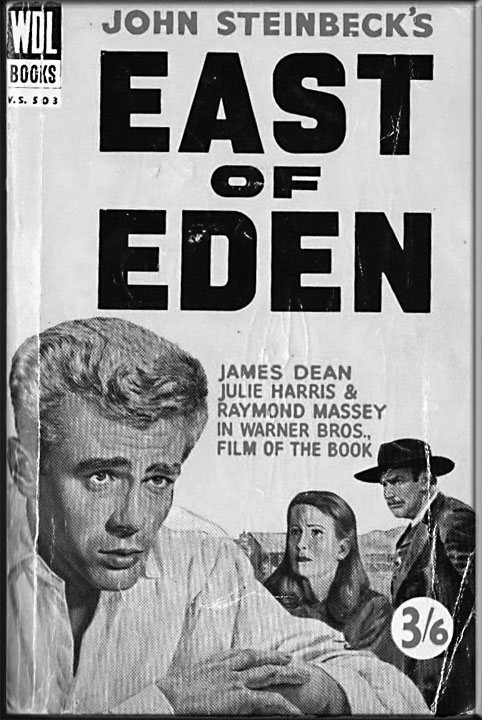 My journey from East of Eden to Silicon Valley and Steinbeck Country began in the early 1960s. One summer I worked in a west London warehouse that stored spare parts for a Royal Air Force aircraft maintenance unit, helping the aged custodian move engine parts and other heavy objects during a business slowdown. Not many RAF planes seemed to be in distress, so I had plenty of time to read on the job. One day my boss picked up a worn paperback novel and tossed it to me: “Here, catch this. It’s got some dirty bits in it. You might like it.”
My journey from East of Eden to Silicon Valley and Steinbeck Country began in the early 1960s. One summer I worked in a west London warehouse that stored spare parts for a Royal Air Force aircraft maintenance unit, helping the aged custodian move engine parts and other heavy objects during a business slowdown. Not many RAF planes seemed to be in distress, so I had plenty of time to read on the job. One day my boss picked up a worn paperback novel and tossed it to me: “Here, catch this. It’s got some dirty bits in it. You might like it.”
It Started in England with East of Eden
A semi-clothed maiden on the well-thumbed cover promised the pleasures of a “bodice ripper”—not my usual choice of reading material. But having swept the aisles for the day and with nothing else to do, I dug into my first Steinbeck novel. Yes, there were a few racy bits to be found in To a God Unknown, but the bold writing style and the imagination behind the storytelling captivated me far more. By the end of the summer I’d read every book by John Steinbeck I could find, including East of Eden. I still have the yellowing paperback copy with James Dean and Julie Harris on the cover that set me back three shillings and sixpence from my warehouse wages.
Images of “light gay mountains full of sun and loveliness” and hot, dry afternoons near Jolon in Steinbeck’s Valley of Nuestra Señora proved particularly appealing during that typically cold, damp English summer. I vowed that one day I would travel to California and see Steinbeck Country for myself. It was a promise I would keep in my five-decade odyssey from England to Silicon Valley and Steinbeck Country. I even got an unanticipated boost along the way from the Oprah book club—but that lay far in the future.
Stop #1: Silicon Valley
After graduating from college with a degree in physics, I found employment in England in the booming new business of semiconductor electronics. Within a few years I was working for a European affiliate of Fairchild Semiconductor, the Mountain View company that spawned Intel and other Silicon Valley “Fairchildren” startups. Sensing that the real action in the buoyant computer chip industry was in California, after several years working in England I negotiated a transfer and arrived in San Francisco in 1968. It was the first stop in my Silicon Valley-Steinbeck Country-Oprah book club journey.
Although I only planned to stay in California for a couple of years, I continued to live and work in Silicon Valley until I retired 15 years ago. During that time the Santa Clara “Valley of Heart’s Delight” morphed into Silicon Valley, and the microchip business evolved from maverick entrepreneurial startups run by cowboys with clipboards to strategic assets managed by nation states.The number of transistors on a silicon chip swelled from a dozen or so to more than one billion, and Silicon Valley became an international brand.
I visited Steinbeck Country—the agricultural Salinas Valley, the fishing town of Monterey, and peaceful Pacific Grove—several times during the early years of my Silicon Valley career. I walked the hallowed length of Monterey’s Cannery Row, peered into Steinbeck houses in Monterey, Pacific Grove, and Salinas, and hiked some of the lower trails into the Big Sur country, the setting for Steinbeck’s story “Flight.” I also took classes from the well-known photographer Steve Crouch, inspired by his classic 1973 coffee-table volume, Steinbeck Country.
Back in the days before the National Steinbeck Center, Salinas was a sleepy stop on the road south from Silicon Valley. Cannery Row was showing early signs of recovery as a tourist destination from the collapse of the sardine industry predicted by Steinbeck and his best friend, the marine biologist Ed Ricketts. But I remained a captive of the Silicon Valley siren call until retiring in 1998. By then much had changed in Steinbeck Country, home turf for the author of East of Eden, since my early trips down Highway 101 from Silicon Valley.
Stop #2: Steinbeck Country
When I retired I began to submit day-trip features to the travel sections of the San Francisco Chronicle and the San Jose Mercury News, including an article on Salinas, where the National Steinbeck Center had recently opened. That event was international news, but travel-section advertisers failed to find the destination compatible with selling big-ticket vacation cruises, and neither paper took my piece on Steinbeck’s hometown. I was beginning to understand how Steinbeck felt before his first book was accepted.
Eventually I sent my effort to Susan Shillinglaw, a professor of English at San Jose State University and at that time the director of the Center for Steinbeck Studies. She published my article—“Something to Do in Salinas”—in the fall 2001 issue of Steinbeck Studies, and she invited me to show slides of places in Steinbeck Country related to Steinbeck’s fiction at the Steinbeck Centenary Conference, held on Long Island at Hofstra University in 2002. Steinbeck wrote much of East of Eden in his Manhattan apartment; eventually he also bought a house in Sag Harbor, the Monterey-like fishing village on Long Island that provided the setting for The Winter of Our Discontent.
Following my presentation at Hofstra several attendees asked for copies of the images I’d shown. I used an early-generation digital camera with a state-of-the art two-megapixel sensor to take my pictures, and copies could only be printed at postcard size. Naturally I was eager to find a way to satisfy Steinbeck lovers who wanted permanent images of Steinbeck locations, and eventually I settled on a format that allowed several small photos to be printed per page in the book I produced.
Published in 2003 as a low-cost souvenir and travel guide, Steinbeck Country: Exploring the Settings for the Stories sold steadily at the National Steinbeck Center, online, and through other outlets. After Susan included a page about the book on the website she edited for the Oprah book club selection of East of Eden later that year, sales spiked.
Stop #3: The Oprah Book Club
Exposure on the Oprah book club website generated invitations from community book clubs and libraries for presentations about Steinbeck Country. It ultimately led to new Steinbeck Country travel-writing and photography opportunities as well, along with requests to provide images for academic publications such as East of Eden: New and Recent Essays, a recent collection of scholarly articles edited by Henry Veggian and the late Michael J. Meyer.
But the market for printed travel titles has changed dramatically since I published my guide book 10 years ago. Today digital versions are preferred over print because of their portability, flexibility, and ease of updating. To serve the growing market for mobile-device apps, I partnered with the National Steinbeck Center to transfer the book’s content to digital format.
Introduced at the Steinbeck Festival in May of 2013, the Steinbeck Country & Beyond app contains over 200 pages and almost 1,000 images, compared with only 32 pages and 100 or so photos in the printed book. An easy-to-use mobile reference and travel guide to Steinbeck’s works and the people and places that inspired them, the app is available from Apple’s iTunes App Store and on Google’s play for Android platforms. There is also a website version for readers who do not have access to a smartphone or a tablet.
Only a writer as creative as Steinbeck could have predicted 50 years ago where my path would lead. From reading East of Eden in England to a career in Silicon Valley and retirement in Steinbeck Country—with an unanticipated boost from the Oprah book club along the way—my story continues to surprise even me.
